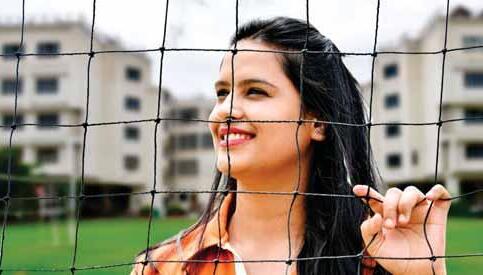












Rotarians and Rotary clubs, or districts, that undertake wellplanned and meticulously executed projects that benefit the local community, transforming people’s lives, naturally want them known to other Rotary clubs. What better way to do this than to showcase the project in Rotary News, which is circulated to over 1.3 lakh Rotarians, about 1,000 public libraries, educational institutions, doctors’ waiting rooms, clinics, etc and read by over 4 lakh readers every month?
the different stages of the project, keeping in mind the fundamental criteria of journalism.
• Genesis — When was the project conceived.

We at Rotary News would like to feature the good service projects that Rotary clubs implement. But our problem is lack of informaton about the good projects, while routine projects keep demanding space. While most of the times we are flooded with routine welfare projects, which we don’t deny are required by the community, such as blood donation events, gifting a vehicle, medical equipment or cataract screening, we often miss out on the bigger, better, or smaller but unique projects for the simple reason that the club do not share them with us.
So here is an invitation to get your communication right; assign somebody in your club to tell us about your major projects. If you think they need to be shared with the rest of the Rotary world, please document, or make an info sheet of
• Cause — Why was it planned; obviously to fulfil the needs of the local community. Describe this need.
• Cost — How was the money raised; was it a TRF grant?
• Challenges — Was finding the money a problem? Were government clearances required; how were these obtained? Other challenges and finding of solutions.
• Execution — The timeframe in which the project was completed; the different stages.
• Beneficiaries — You will have the best chance of getting your club’s project into Rotary News if you give us human interest stories… pictures and interaction with the beneficiaries.










• Pictures — Take good, action photographs of the project and its beneficiaries, send them in high resolution, original size.
• Project heroes — Highlight the Rotarians who were passionately involved in the project, even if they are not the club leaders and are silent workers.
Once you have all this in place, invite us to visit your project. Do remember we have only one magazine a month and there is a lot of demand on this space. So, as one RNT Trustee pointed out at a recent Board meet, differentiate between that which is fit for the GML, and that which can go into the national magazine for Rotarians.
Give us your best project for the magazine, rather than sending all kinds of activities, such as distribution of blankets, books or benches.
Finally, remember that we are not looking only at mega projects which cost hundreds of thousands of dollars in global grants. Even a small project that has a unique idea, and gives a simple, outof-the-box solution to the local community, is welcome.

Do send suggestions to: The Editor at rushbhagat@gmail.com
• As Rotary is keen to get more women and younger members, give us projects done by this group.


Senior Assistant Editor at jaishri67@gmail.com Editor

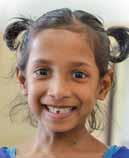
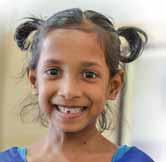
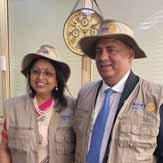
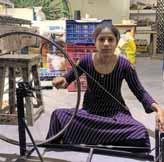
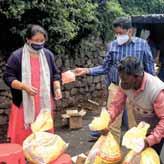
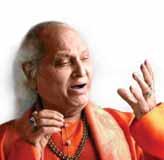
12 Mending little hearts, the Sanjeevani way Rotary promises support to the Sathya Sai Sanjeevani hospitals that treat paediatric cardiac patients from underprivileged families.
20 Africa is an unpolished jewel in the Rotary crown
In an interview to Rotary News, RI President Shekhar Mehta talks about his 7-nation tour of Africa where he met the heads of states and assured them of Rotary’s support to local communities.
32 Caution continues to be the need of the hour in combating Covid RI Covid Task Force chairman PRIP KR Ravindran shares Rotary’s action plan to tackle the pandemic and promote vaccines worldwide.
38 Weaving colourful dreams
A project of RC Bilaspur Queens that helps the women silk weavers of Umreli village market their creation at better prices, and help them in other ways.
42 Along with government, RC Kodaikanal vaccinates entire hill town
The club spent `1.13 crore to provide relief to the local community at Kodaikanal during the pandemic.
62 From home to ‘smart home’
Read about some great concepts that can make your home fully automated and environment friendly.
64 Pandit Jasraj — A music veteran who walked tall
Known for his soulful voice and multi-octave range, he was one of the most famous performers in Hindustani classical music.

On the cover: A child with congenital heart defect syndrome being treated at one of the centres of the Sathya Sai Sanjeevani Hospitals.

The cover photo of PM Modi receiving RI President Shekhar Mehta was nice. Mehta’s message on educating girls and the Editor’s note on the plight of Afghan women under Taliban regime are spot on. Kudos to Erode Rotarians for building a ` 20-crore hospital in 45 days. Great to read about the hospital for burn victims in Coimbatore. RC Delhi’s Beti Siksha is a novel project. Mehta’s announcement on recognising those who bring members will yield good results in a short span. A Marathon Man by PRIP Rajendra Saboo is worth reading. All articles are well-written and pictures are
The plight of Afghan women
The editorial on the fate of Afghan women is timely. To help education in Afghanistan, RC Emerald City and other clubs in RID 5030, Seattle, US, are reported to have committed to support the activities of the local Afghan NGO, Agriculture, Health and Development Organisation (AHDO), which had constructed a new school there. The then Ministry of Education provided instructors and support staff to operate the school and may continue to do so. We hope the education of girls is not neglected.
KMK Murthy RC Secunderabad — D 3150
The visuals of the Taliban beating Afghan women are really disturbing. The new Islamic government has a dozen plus ministers who are on the United Nations’ terrorist list. This government has the tacit support of several countries. Only a civil rebellion by the citizens of Afghanistan with support from countries around the world
Mehta meets Modi
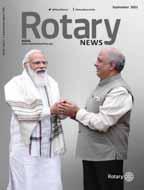
eloquent. A neat job by the editorial team.
Philip Mulappone MT RC Trivandrum
Suburban — D 3211
President Mehta meeting PM Modi is a booster shot for
can save the children and women of this jinxed country.
Koka Dayanand RC Nellore — D 3160
My compliments for yet another brilliant issue with content having a nice blend of emotions, information, focus and inspiration to align with the theme of Serve to Change Lives. Reading your editorial on the plight of our Afghan sisters living under Taliban rule brought tears to my eyes. Afghanistan is rife with violence, which is now exacerbated to the level of tyranny and cruelty. I wish we could all do something for them. The article 10 years of giving hope to burn victims is inspiring and it is lovely to see our club’s project Beti Siksha being featured.
Kriti Makhija
RC Delhi South — D 3011
The plight of Afghan women after the Taliban takeover of their country is vividly narrated in the editorial. Now,
Rotarians. I turned all the pages of the magazine to read about the details of their meeting but couldn’t find them. Hopefully we will be given these in his next message. R Srinivasan, RC Madurai Midtown — D 3000
We’re proud to see the picture of PM Modi with President Mehta, and hope his tenure will be a golden period for Rotarians, particularly in India. Modi is a proactive leader and I am sure that Rotary clubs will contribute significantly to India’s development under Mehta’s leadership.
Anil Saxena RC Lucknow — D 3120
the Taliban are showing their brutality on journalists too with horrible scenes being aired on TV channels.
Afghan novelist Khaled Hossieni, a goodwill UNHCR envoy based in California, in his book A thousand splendid suns has lamented the fate of Afghan women under the Taliban regime. God save Afghanistan.
Edward Mendonsa RC Shankerpura — D 3182
Erode hospital, a colossal effort I am amazed by the speed and energy with which RID 3203 Rotarians built a ` 20 crore super specialty 400-bed hospital in just 45 days. A colossal effort was made by PDG Dr Sagadhevan, his team, and DG Shanmugasundaram. A salute to these Rotarians.
S Mohan, RC of Madurai West — D 3000
Rotarians are proud of the Erode Hospital built in 45 days. This will
enable training of 150 more doctors. A noble work by Erode Rotarians
TD Bhatia, RC Delhi Mayur Vihar — D 3012
The building of the Erode Rotary Hospital in just 45 days proves once again that Rotarians can achieve much bigger things if they believe in themselves. I hope that Rotary continues to maintain this medical facility as requested by the Erode GH dean Dr Mani.
Rm Muthukaruppan
RC Sankarapuram — D 2982
We have to appreciate the tremendous work done by Erode Rotarians in setting up the 400-bed Covid hospital. PDG EK Sagadhevan is the spirit behind this project. If we know how they got the raw material, other clubs could also do such mega projects. Said RI Prez Mehta: “In my 36 years in Rotary, I haven’t seen a single project of this magnitude.” Hats off to Sagadhevan and his team for this wonderful service project.
N Jagatheesan RC Eluru — D 3020
I compliment you and the entire team of Rotary News for doing a good job issue after issue with balanced coverage of diverse subjects. Kudos to Erode Rotarians for setting up a ` 20-crore hospital in 45 days. It is interesting to read about a renowned singer/musician in each issue.
Shivkumar Israni RC Bombay — D 3141
Health projects carried out by different clubs made good reading. The TANKER’s state-of-the-art dialysis centre and the complex heart surgeries being done by RC Bombay are worth reading. These are inspiring projects.
Dr Sanjay Kolte
RC Nagpur — D 3030
President Mehta’s message on increasing membership is timely. To engage new members, good communication, understanding, caring and respect are crucial. We should appreciate the work of new members and guide them to understand the club’s vision, values and projects.
Naveen Garg, RC Sunam — D 3090
It was so thoughtful of you to publish a black and white cover page for the great legend Dilip Kumar. I compliment you and your team for the excellent coverage on the late thespian.
Prabhat Kedia
RC Guwahati — D 3240
Rotary building a bridge in a small hamlet at Shegaon taluk in Maharashtra is noteworthy as it helps the farmers to market their produce. Rotary Hockey Foundation is doing a commendable job of training over 200 Odisha girls in hockey and the Rotarian coach spending over `20 lakh from his pocket in this endeavour is commendable.
Pon Muthiayan
RC Aduthurai — D 2981
President Mehta has urged clubs to celebrate Rotary Days to boost membership and as a public image-building exercise. Editor’s priority to write articles on women’s empowerment and girls’ eduction is most welcome. Rtn Jatinder Sharma has enriched Rotary by taking up coaching of Odisha girls in hockey. The article How a wedding reception
led to creating a rural eye hospital is interesting; and the construction of check dam in Rajasthan by Delhi clubs is worth cherishing. All articles are eminently readable, especially those of general interest to readers.
R Thayumanavan
RC Cuddalore Midtown — D 2981
Rotary Plus
Our thanks and appreciation for publishing the article Covid awareness drive in tribal hamlets in the August issue of Rotary Plus with this event on the cover. God bless the editorial team
D K Zarekar
RC Nasik-Ambad — D 3030
During induction, new members at present extend their arm forward with an open palm facing downward, which is a Nazi salute in Hitler’s Germany. Rotary is an organisation that promotes peace, friendship and goodwill. Whereas, Nazis are racist and cruel. I suggest the right forearm of a prospective member, at the elbow, be held upright with an open palm facing forward. This is the posture of peace greeting. Do consider this.
Ramakrishna K, RC Puttur — D 3181
In the September issue, on Pg 63, Hariprasad Chaurasia is wrongly mentioned as Bhimsen Joshi in the caption of the photo with Kishori Amankar. The error is regretted. Editor
We welcome your feedback. Write to the Editor: rotarynews@rosaonline.org; rushbhagat@gmail.com. Mail your project details, along with hi-res photos, to rotarynewsmagazine@gmail.com.
Messages on your club/district projects, information and links on zoom meetings/ webinar should be sent only by e-mail to the Editor at rushbhagat@gmail.com or rotarynewsmagazine@gmail.com. WHATSAPP MESSAGES WILL NOT BE ENTERTAINED.
Click on Rotary News Plus on our website www.rotarynewsonline.org to readabout more Rotary projects.
Greetings, my dear changemakers. A quarter of the Rotary year is now behind us. I am sure you are helping Rotary to grow more and do more . And I hope you have already done your part for the Each One, Bring One initiative by introducing one person to Rotary.
Do you ever think about your earliest days as a Rotarian? I often do — because those first moments of discovering the power of service shaped who I am today. When I joined my Rotary club, our efforts focused on India’s rural communities, where people were living without toilets, getting their drinking water from the same pond they bathed in, and sending their children to outdoor classrooms set up under a tree. The nearest healthcare provider often was miles away — and the services were inadequate. But after Rotary clubs carried out some service projects, the villages had toilets, clean drinking water, a classroom for early learning, and a nearby healthcare centre.
The spark that Rotary kindled within me forced me to look beyond myself and embrace humanity. It made service a way of life and led me to a guiding principle I still stand by: Service is the rent I pay for the space I occupy on Earth.
Economic Development Month — is a great time to do so. When we work to improve the lives of people in underserved communities — through, for example, projects that provide vocational training and access to financial resources — we help build and sustain local economic growth.
The need is great. According to the United Nations, 9 per cent of the world’s population — that’s 700 million people, a majority of them in sub-Saharan Africa — live on less than $1.9 a day. By supporting strong community development as well as entrepreneurs, we can help improve conditions for people in that region and others.
Your club can also promote economic development in your own community by expanding vocational training opportunities through local schools and community colleges, partnering with lenders to improve access to financial services, or working with a nonprofit that provides resources to entrepreneurs and connects them with the business community.

ensure that all children are immunised against polio. Please don’t forget to activate your clubs on that important day and encourage them to donate here: endpolio.org/world-polio-day.
Service has been rewarding for me throughout my life. I know the same is true for many of you. Join me this month in becoming a good tenant of our planet by helping others to better themselves and their communities. Together, we can Serve to Change Lives.

If you feel the need to reignite the spark of service in yourself or your club, October — Community

Of course, developing strong communities is impossible without strong public health. On Oct 24, World Polio Day, we’ll celebrate our tremendous progress in the effort to eradicate polio. But we also know the fight is not over. We still need your help raising funds and awareness to

Shekhar Mehta President, Rotary International


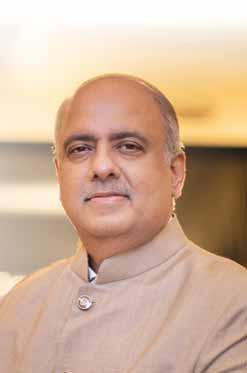


ow conscious and receptive the entire world has become of the urgent need to improve the lot of girls and women is amply evident from two different, and yet related, issues. As can be seen from his social media posts, and interview to Rotary News, RI President Shekhar Mehta is absolutely delighted at the kind of traction one of his focus areas for his year as president — empowering girls — is getting across the world. On a 7-nation 20-day tour in the African continent, he was delighted to find the kind of passionate support this cause is getting among the African Rotarians. “Wherever I went, I saw great passion and enthusiasm in doing projects to empower girls,” he said. While the Pad-a-Girl project is training girls to make reusable sanitary pads, covering three crucial service areas such as health and sanitation, environment and empowerment of girls/women, another project that moved him was scholarship for girls within the internally displaced population.
We know that a plethora of Rotary clubs across the world are executing projects focused on the education of girls and skilling women. In Bilaspur, Chhattisgarh, Rotary Club of Bilaspur Queens, an all-women’s club, is helping women weavers who make the beautiful kosa silk sarees, which occupy the pride of place in women’s wardrobes. The club has launched the Sapno ke dhaage project to help support these women in myriad ways, including marketing their ware, giving them additional skills in tailoring and embroidery, loans for small enterprises, and in the future, some help to cope with the expenses involved in the marriage of daughters.
The other gender issue is of course the continuing concern with the worsening plight of Afghanistan’s
girls and women, whose rights are being crushed under the Taliban rule. But what is heartening is that this time around, the Afghan women — within the country and outside — are putting up a spirited fight, in whichever way they can. One brave social media campaign that Afghan women took up in September on Twitter had the hashtag #DoNotTouchMyClothes . Through this campaign Afghan women posted pictures of themselves, teenagers, their mothers, aunts, sisters, all dressed in colourful, traditional Afghan costume, which neither covers the face nor hair. This is a desperate attempt by the women to reverse their diminishing rights under the Taliban, which has allowed education for boys to resume but put all kinds of restrictions on girls’ education. Through this campaign, the Afghan women are clearly telling their rulers that in their tradition, “niqab and burqa were never a part of the Afghan dress code for women.”
To get a taste of how draconian and restrictive girls’ education, when it begins, as has been promised by the Taliban, will be, let’s look at The New York Times quoting Aqilla, the director of a girls’ school in Kabul, who “desperately wants to learn details of the Taliban’s plan for girls’ education. But she can’t attend the weekly Taliban committee meetings on education. They are for men only. “They say, ‘You should send a male representative,’” she told NYT!
She and others engaged in education for girls don’t need to attend meetings to realise that both girls’ education and women’s rights will be severely curtailed by the Taliban regime.
Rasheeda Bhagat
RID 2981
RID 2982
RID 3000
RID 3011
RID 3012
RID 3020
RID 3030
RID 3040
RID 3053
RID 3054
RID 3060
RID 3070
RID 3080
RID 3090
RID 3100
RID 3110
RID 3120
RID 3131
RID 3132
RID 3141
RID 3142
RID 3150
RID 3160
RID 3170
RID 3181
RID 3182
RID 3190
RID 3201
RID 3203
RID 3204
RID 3211
RID 3212
RID 3231
RID 3232
RID 3240
RID 3250
RID 3261
RID 3262
RID 3291
S Balaji
K Sundharalingam
R Jeyakkan
Anup Mittal
Ashok Aggarwal
Rama Rao M
Ramesh Vishwanath Meher
Col Mahendra Mishra
Sanjay Malviya
Ashok K Mangal
Santosh Prdhan
Dr Upinder Singh Ghai
Ajay Madan
Parveen Jindal
Rajiv Singhal
Mukesh Singhal
Samar Raj Garg
Pankaj Arun Shah
Dr Omprakash B Motipawale
Rajendra Agarwal
Dr Mayuresh Warke
K Prabhakar
Thirupathi Naidu V
Gaurishkumar Manohar Dhond
A R Ravindra Bhat
Ramachandra Murthy M G
Fazal Mahmood
Rajasekhar Srinivasan
Shanmugasundaram K
Dr Rajesh Subash
Srinivasan K
Jacintha Dharma
Nirmal Raghavan W M
Sridhar J
Dr Mohan Shyam Konwar
Pratim Banerjee
Sunil Phatak
Santanu Kumar Pani
Prabir Chatterjee
Printed by PT Prabhakar at Rasi Graphics Pvt Ltd, 40, Peters Road, Royapettah, Chennai - 600 014, India, and published by PT Prabhakar on behalf of Rotary News Trust from Dugar Towers, 3rd Flr, 34, Marshalls Road, Egmore, Chennai 600 008. Editor: Rasheeda Bhagat.
The views expressed by contributors are not necessarily those of the Editor or Trustees of Rotary News Trust (RNT) or RotaryInternational(RI).Noliabilitycanbe accepted for any loss arising from editorial or advertisement content. Contributions — original content — are welcome but the Editor reserves the right to edit for clarity or length. Content can be reproduced with permission and attributed to RNT.
Let’s usher in a peaceful world
Fellow Rotarians,
Rotary International has a long history of peace building initiatives. From a preWorld War I resolution calling for maintenance of peace, establishing peace centers and now supporting the environment, Rotarians have the required resources and thought process to address the conflicts in our world because of violation of basic human rights. Rotary never believes in passive preaching of peace. Instead, we have championed the peace process by involving and inspiring people we serve. Rotary stands for sustainable peace for all. However, in today’s world, over 70 million people are affected because of conflict and violence. Neither peacekeeping forces nor state and international institutions can reduce widely prevalent human rights violations. The Afghan crisis is an example.
Remember, nearly half of the affected population comprises children. We cannot accept the situation as it is. We have all the tools and resources with us. We have a proven track record of building peace and binding communities through our projects. In the past, Rotary had trained volunteers and imparted skills to people and societies. The time has come to re-emphasise the peace process and invest in peace.
Children make up one-third of the global population, with 1 in 6 children living in extreme poverty. Six million children under 5 die each year because of
malnutrition and many more are abused, exploited and enslaved. This is the state of affairs even after united efforts by kind-hearted people and service-minded institutions around the globe.
So let’s refuse to accept conflict as a way of life. Let’s think, say and do peace. In order to preach and practise peace, we need to engage, educate and empower communities and people around us. Rotarians are champion peacemakers. Peace is possible when Rotarians plan and execute projects in disease prevention, giving access to clean water, saving mothers and children, supporting education, protecting environment and empowering societies economically and emotionally.
Rotary is nothing but humanity in action. Peacebuilding is an inbuilt ingredient of all our actions and deeds. However, in today’s challenging environment, we need to focus more and put peace efforts at the heart of all our activities. Each action must be reviewed and re-designed to include peace. Our ultimate goal should be a peaceful and conflictless society. We must work for more meaningful and impactful projects which can bring and create an environment for change and a conflict-free world. Our vision and mission must give hope for peace. Trust me, together, in the second century of service to mankind, we shall be more successful and impactful than before.
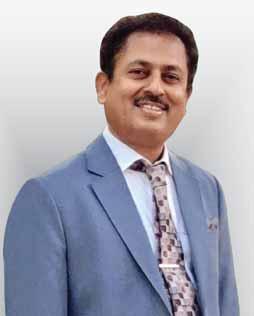



Dr Mahesh Kotbagi
RI Director, 2021–23

It is heartening to see clubs and districts around our country slowly and cautiously inching back to pre-pandemic levels of activity. I also notice that clubs have been quick to adopt relevant technology, wherever needed. Though we must not let our guards down, life must go on. As I see this around me, my thoughts go back to over two decades ago when as a fairly new Rotarian I watched a young girl refusing to get off the new bench donated to her school by my club. The image that is etched in my memory is that of this young girl confessing that this was the first time in her life she was sitting on something other than the ground and that she wanted to experience that joy for a little longer. That was a life-changing incident not only for her but for me too. My outlook to life changed that moment. My bonding with Rotary grew stronger.

Board of Trustees
Shekhar Mehta RID 3291
RI President
Dr Mahesh KotbagiRID 3131
RI Director & Chairman, Rotary News Trust
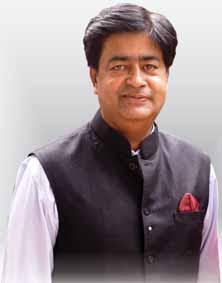
are engaged in some activity or the other of their choice.
Many studies have revealed that the GenNext looks to get a hands-on experience of working in their community and making a difference through their clubs and that would be the main reason why they join or continue in Rotary.
I am recalling this incident to emphasise the importance of engaging our club members as one will never know which experience is going to be a life-changing one. People join Rotary for various reasons and most of them may well be reasonable. However if there is one thread that connects all those reasons, it will be the desire to be engaged in some form or the other. Some may consciously seek the opportunity and others may wait for it to be offered to them. Clubs in our zones need to bear this in mind and their leadership should look around and ensure all the members
Feeling good is a prerequisite for doing good. Let us resolve to make available relevant opportunities for our members to engage themselves in activities that will make them feel good about their membership in our organisation. If that happens we will certainly ‘Grow More and Do More’.
People join as members. It is their experience that makes them Rotarians!

AS VenkateshRID 3232
RI Director
Gulam A VahanvatyRID 3141
TRF Trustee
Rajendra K SabooRID 3080
Kalyan BanerjeeRID 3060
Panduranga Setty RID 3190
Sushil Gupta RID 3011
Ashok Mahajan RID 3141
P T Prabhakar RID 3232
Dr Manoj D DesaiRID 3060
C BaskerRID 3000
Dr Bharat PandyaRID 3141
Kamal SanghviRID 3250
Executive Committee
Members (2021–22)
Gaurish DhondRID 3170
Chairman
Governors Council
Anup Mittal RID 3011
Secretary Governors Council
Ramesh MeherRID 3030
Secretary Executive Committee
V Thirupathi Naidu RID 3160
Treasurer
Executive Committee
Jacintha Dharma RID 3212 Member Advisory Committee
Editor Rasheeda Bhagat
Senior Assistant Editor Jaishree Padmanabhan
Now share articles from rotarynewsonline.org on WhatsApp. Rotary News Trust 3rd Floor, Dugar Towers, 34 Marshalls Road, Egmore Chennai 600 008, India. Phone: 044 42145666
rotarynews@rosaonline.org www.rotarynewsonline.org
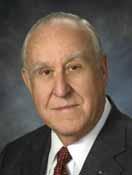
When Rotary courageously stepped up to pursue the dream of a polio-free world, we knew realising our dream wouldn’t be easy. But since 1988, working with our partners, we’ve brought worldwide case counts down by 99.9 per cent. However, it’s not over until it’s over. We’re going to keep up the funding and keep on the pressure until this fight is finished, and no child ever again has to experience the devastating effects of polio.
As we mark World Polio Day on October 24, we can take heart; we continue to make progress, and with the current low transmission rates of wild poliovirus in Afghanistan and Pakistan, we have a unique opportunity to interrupt transmission. We also have a new strategy and vaccine that will bolster our eradication efforts.
To eradicate wild poliovirus and stop outbreaks of circulating vaccine-derived poliovirus (cVDPV), the Global Polio Eradication Initiative’s new strategy centres around several key areas: political advocacy to create greater urgency and accountability in the endemic and outbreak countries, improved engagement with high-risk communities, improved operations and polio surveillance, and the inclusion of polio immunisation in broader health programmes.
Along with our new strategy, Rotary and its partners are using a new tool, novel oral polio vaccine (nOPV2), to help address outbreaks of type 2 cVDPV. This new vaccine has been deployed in a growing list of countries and is a promising development in our quest to end polio once and for all. But there is still much work to be done. We need to remain strongly committed to our goals in the face of recent events in Afghanistan. As a nonpolitical organisation, Rotary will continue to do the work that is necessary to protect the health of children everywhere.
After all the progress we’ve made in our decades-long fight, the worst thing we could do is to become complacent, so here’s where you come in. Let’s double down on our commitment and keep raising $50 million each year for polio. Remember: Thanks to the Bill & Melinda Gates Foundation, any contribution you or your Rotary or Rotaract club makes will be matched 2 to 1. In Rotary, we have always risen to challenges — and now it is more important than ever for us to rise again, with courage, to defeat polio.
John F Germ Foundation Trustee Chair
During the very difficult days of the pandemic, when physical meetings were impossible, technology was a gamechanger and an invaluable resource to stay connected, though virtually. Zoom, or other good platforms, helped us remain in touch during this grim period. Children remained connected to teachers when schools remained shut. Restaurants served customers through online aggregators. The downside is that businesses have suffered immeasurably and children have missed out on physical and social contact. Also, virtual learning has brought to the fore our great income divide. Poor children, whose families could not afford smartphones, missed out on schooling. One hopes and prays that with more and more people vaccinated we will see the pandemic being brought under control and that normalcy returns soon.

In this difficult period, Rotarians did not slacken in their efforts in reaching out to the not-so-fortunate. In fact, they redoubled their efforts; in 20–21, a record 2,066 global grants were approved with total funding of $143.55 million.
The number and value of global grants by way of Areas of Focus have been as follows: fighting disease — 1,020 ($74.75 million); providing clean water, sanitation and hygiene — 341 ($25.71million); growing local economies — 264 ($16.95 million); supporting education — 184 ($12.12 million); saving mother and child —129 ($8.38 million); and promoting peace — 128 ($5.64 million).
The above should give you a snapshot of how our Foundation has helped to do good in the world.
The pandemic has made lives extremely difficult and uncertain for large swathes of the community. This article will appear in October, while Diwali is in the first week of November. Let me wish you, in advance, Happy Diwali. On this joyous occasion I urge you to open your hearts and purse strings. Your gift to the Foundation would spread the light of well-being, education and good health to those who live on the margins and are in need of a helping hand.
As Winston Churchill said, “We make a living by what we get but we make a life by what we give.”

Gulam A Vahanvaty Trustee, The Rotary Foundation


4-8






Rotary at a glance
Rasheeda Bhagat
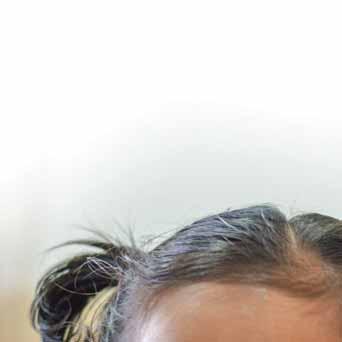
Ibelieve we are trustees of the wealth god has given us; before we were born it belonged to someone else, after we die, it will go to someone else, says Vivek Gour, one of the three trustees of the Sri Sathya Sai Health and Education Trust, which runs three
dedicated paediatric heart surgery centres in India. Named the Sri Sathya Sai Sanjeevani Centres for Child Heart Care, these are located in Raipur, Chhattisgarh; Palwal, near Faridabad in Haryana; and Navi Mumbai.
Gour, a Rotarian, and a member of RC Gurgaon Harmony Iberis, RID
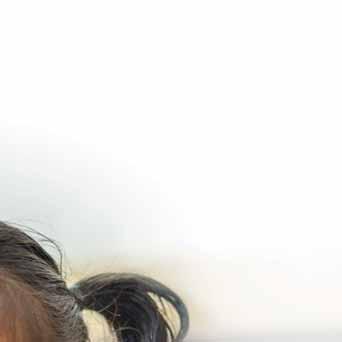
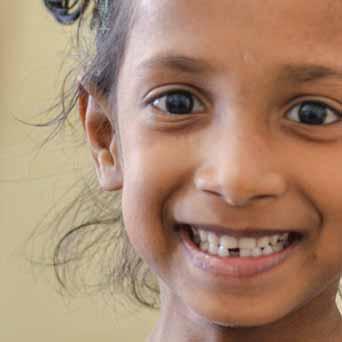
3011, says this without any swagger, while explaining that a few years before his death, the Sai Baba had asked his devotee C Sreenivas to set up five heartcare hospitals to provide completely free heartcare to children. “Sunil Gavaskar, and I, also his devotees, joined Sreenivas to realise this dream. We have already set up three centres, and will be putting up two more,” he adds. All of them have contributed towards setting up these hospitals, which provide totally free medical treatment to children born with congenital heart defects (CHD).
Over three years ago, Gour took early retirement from his business in aviation engineering; and put all his time, energy and passion into running these hospitals.
Totally, about `150 crore has been invested in the three hospitals, with money coming from “philanthropists, Rotary clubs including global grants, and CSR funds.” He estimates that around $2.5 million has come from Rotary, “including GGs and clubs sponsoring children for surgery.”
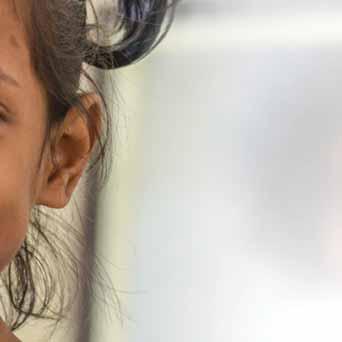
It is estimated that each year 3 lakh children are born in India with CHD and thanks to the dearth of healthcare facilities, and poverty, 1 in 4 of these children do not see their first birthday.
A child with a CHD stays at these hospitals for two weeks, and “her parents can enter without a single naya paisa in their pockets, get their child diagnosed, treated/operated and leave the hospital with no tension about money for subsequent treatment


if required. Often, several procedures are needed to cure the child. And with only three trustees, decisions are made fast.”
On the doctors and other staff getting market rate salaries, he says: “Well, they get normal salaries, which can’t be compared with something close to `6 crore a year being paid in large private hospitals. But those salaries come with the stiff target the surgeon has to meet. Last year, when my mother was admitted in a Delhi hospital, I met a surgeon who earned… I bet you’ll fall off your chair… `13 crore a year!”

Their doctors, he adds, get paid a “decent wage”, and accommodation. But the biggest reward for them is not having to turn away a patient for being too poor, something they had to do often in private hospitals, “knowing very well that the child will die without the surgery that the parents cannot afford. And being human beings, that distressed them a lot.”
Now the institution is nearly 9 years old; for the first three years they got patients by word of mouth. “Today many doctors who can’t provide them relief say aap Sathya Sai baba mei chaley jaon.” With even those with moderate means having at least a smartphone in the family, we are googled. Also, government hospitals, where the poorest of poor go first, refer patients. “We get children from almost every corner of India… Mizoram to Kashmir to Kanyakumari; our waiting list now is 4,000.”
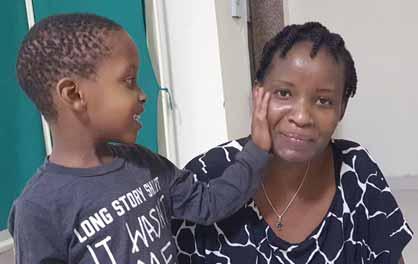



“We don’t turn away anybody, and have also treated children from 14 developing countries such as Pakistan, Afghanistan, Nepal, Bangladesh, Sri Lanka, Fiji, Uzbekistan, Nigeria, Yemen, Ethiopia, Iraq etc. We have conducted four international child heart missions in Fiji and Nigeria.”
Vivek Gour,
trustee, Sri Sathya Sai Health and Education Trust, with a
child.


paediatric cardiac outpatients and performed over 16,000 open heart surgeries and non-invasive catheter interventions on children, which would cost between `2–7 lakh in
He adds that since commencement in 2012, these centres have managed over 135,000
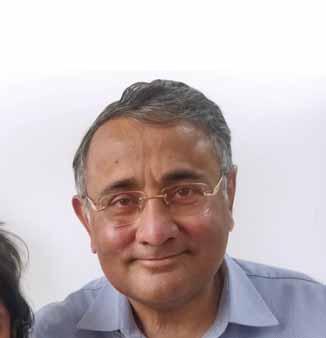

private hospitals, but here the cost is only `1.5 lakh.
RI director Mahesh Kotbagi is most impressed by their “zero-rupee concept.” He visited the Raipur hospital, along with RI President Shekhar Mehta, PRID Kamal Sanghvi and Rajya Sabha MP Vivek Tankha, in August, when Mehta inaugurated an oxygen plant donated by RC Raipur Royal, RID 3261, at a cost of `1 crore, through a TRF global grant.
A doctor who runs his own hospital in Pune, Kotbagi says that normally a paediatric surgery to repair a CHD costs around `5 lakh, “including pre-surgery diagnostics, battery of tests, lab services, cath intervention, blood, medicines and consumables, surgery, hospital stay and postoperative cost. But here it costs only `1.5 lakh.”
He adds, “I have compared this hospital with many others that do charitable work, but no centre comes anywhere close. They have 150 beds in the Raipur Hospital, 125 in Palwal in Haryana and 75 in Khargar, near Navi Mumbai.” In a typical month, the Sanjeevani hospitals do between 350 to 500 surgeries; 500 was average but in the last 18 months, due to Covid, the numbers went down.
“This is a huge challenge, if you consider that a paediatric surgery in a neonatal intensive care unit is very challenging.” Some children are barely a few days, or weeks old, and “can’t talk or tell the doctor that I am breathless.”
The nursing in a paediatric surgical unit is “not normal ICU nursing, but a 24x7, highly specialised job right from changing a nappy or sponging the child to feeding her,” says Kotbagi.
Complex heart surgeries are also done here; “even if the child is now 20, we still do the surgery, but of course such cases are very rare. Because most of those children die before they reach 20,” says Gour. Their youngest patient was a one-week-old child; many children require multiple surgeries, and “we know if we don’t do it, nobody else will and the child will die,” says the trustee.
I next ask Gour about the gender mix in the children being brought for surgery, because we know that in many homes saving a boy’s life matters more than saving a girl. He says that though they roughly see 60 per cent boys compared to girls, “quite often, we find many women, and I am ever so proud of them, who come alone with their girl child, often with their own
RI Director Mahesh Kotbagi visits an operated child.
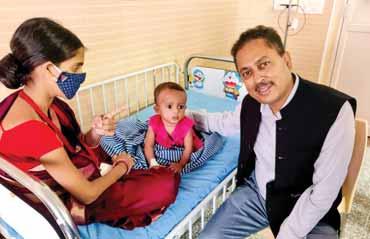

mothers, seeking treatment because the father and his family have abandoned the child as she was born with a CHD.”
Sadly enough, he adds, they also see family reunions after the child’s heart has been repaired! The father then comes back and reclaims the child.
Iattend the “gift of life” ceremony that the Sanjeevani hospitals do for all the children who go home after their hearts
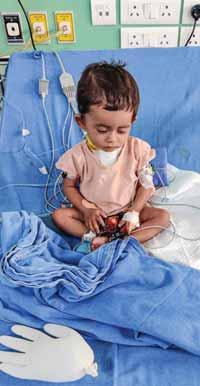
have been mended. Aaliya Fatima, from Palamu in Jharkhand, is a little over 3 years old. When she was just one month old, she had an eye problem and while being checked for that, her CHD was diagnosed. “They
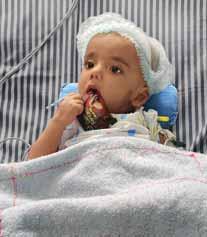
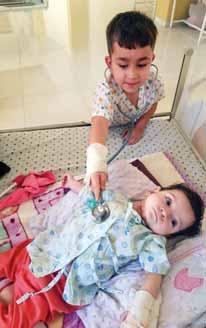
A child from Kurdistan, Iraq, treated at the hospital.
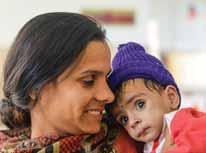
were told that it would cost `6.5 lakh for the surgery. She is the fourth child, and her father Javed Ahmad owns a small shoe shop; the family simply did not have the money for the surgery,” says Ravikumar Sreepadha, who is the Trust officer for the Raipur centre.
Aaliya got operated upon on Aug 10, and was ready to go home in 10 days, and once her family doctor gives the green signal, will start going to school.
Dakshita Sharmita’s story is heartwarming; when her mother Jyoti was pregnant, the sonograph showed some problem in the foetus’s heart. The child was born a robust 3kg-baby, but when she completed 3 months, she started having severe cold and cough episodes. An Echo,
We don’t turn away anybody, and have also treated children from 14 developing countries, and have conducted four international child heart missions in Fiji and Nigeria.
Vivek Gour
Trustee,
Sri Sathya Sai Health and Education Trust
done at a medical college hospital, revealed a big hole in her heart. The family came from Hisar district in Haryana and the father, Ramesh Sharma, worked as a mechanical engineer in Mumbai. They were told an immediate operation was required, so they rushed to a large private Mumbai hospital where the tag for the surgery was put at `10–20 lakh, a sizable advance demanded, and the risk put as “very high”. Another hospital in Bengaluru put
the cost at `7 lakh as a complex surgical procedure was required.
Around this time the parents got a Whatsapp message telling them about the Sri Sathya Sai Sanjeevani hospital in Raipur. They brought the child here, were told that “while there was risk, the team would try its best to make her fine,” adds Sreepadha.
The surgery was done successfully in Nov 2015; “she had a very stormy
Once the operations have been done, follow up is done diligently… after one month, six months or a year or even two years later, depending on individual cases. Two of the three children, who had been operated here, have grown up and even got jobs at one of the hospitals; a 21-yearold has become a lab technician, says trustee Vivek Gour! He adds, “Once the child has gone back home, we call once a year for 3–4 years to find out how the kid is doing. Is she going to school, etc; 100 per cent go back to school and lead a healthy life.”
He puts it succinctly when he explains: “My heart is 60 years old and filled with all the ghee, oil and chocolates I’ve eaten for 60 years. But a 3 or 6-month child’s heart is pure and clean, and has trouble only because of a congenital or engineering defect. When that defect is corrected then it functions like a brand new heart. So, within a week the child is running around the ward, playing football, the mother can’t control him because after 2 or 3 years the child has found that energy for the first time in his life.”
ID Mahesh Kotbagi, who visited the Sanjeevani hospital in Raipur, along with RI President Mehta, was so impressed by the ethos of the Sanjeevani hospitals… “can you imagine that they do not turn away a single child, and have the concept of walk-in patients”... that he spontaneously made a far-reaching announcement. “Our president, Shekhar Mehta, turns 62 this October. The best gift I can give him is sponsoring 62 free heart operations to celebrate his birthday. Shekhar was very touched, and he said if Mahesh is doing 62, I will match with another 62 sponsored surgeries.”
With the average cost of each surgery pegged at around `1.5 lakh or so, this will mean a project of `2 crore from Rotary. “I appeal to individual Rotarians and clubs through Rotary News to sponsor one or more children, as this is really a mind-blowing service project. The GG option is there too but I am not depending too much
on it, as it is very popular and there is so much demand on it, but we can also approach corporates for CSR funds.”
He said he was very heartened by the fact that in “two days, when I told some friends that I want to save some children’s lives, can you help… it will cost `1.5 lakh, and you will get tax exemption, I got 20 sponsors from both Rotary and outside Rotary.”
Kotbagi said that while he went around the wards, he met one Kenyan mother and her child. “For a free paediatric heart surgery, East African countries have a waiting period of 8–10 years. A Kenyan woman, who’d come to India to get her child operated was referred here and she was amazed to get it done totally free.”
He added: “Anybody who wants to give sanjeevani amrut to save a child’s life can contact me to sponsor a child, and meet our target of saving the lives of 124 (62+62) to celebrate President Shekhar’s 62nd birthday.”
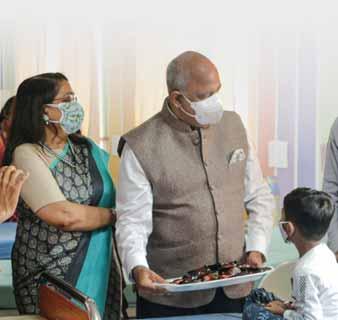

He adds a poignant moment from his life as a doctor. “Once on a medical mission in East Africa, I asked a woman about the prevalent racism against blacks in Africa, and she said, “I don’t know what is a black or a white human being. I only know that when I delivered a child it was a blue baby (with a CHD or hole in the heart), but in the same street, the same day, another woman delivered a pink baby (with a normal heart). So, I only know the difference between a blue (ill) baby and a pink (healthy) one.”

A unique concept at this hospital, given the terminology “working meditation” is that over the years, the parents of the children, who have little to do as their daughters or sons are taken care of by the hospital staff, have started volunteering. So, while Dileshwar’s mother made rotis in the kitchen, many of the fathers, some skilled farmers, helped out in the garden. Yet others keep the floors and the toilets clean; those with skills in plumbing or electrical appliances help in carrying out associated repairs. Says Kotbagi, “This is a novel concept that has simply evolved over the years…. The new set of parents watch the older parents helping out and automatically volunteer to do what they know best… cook, clean, or grow vegetables!”
Rotary has had a close association with Sanjeevani and Kotbagi adds that being a trust hospital, the Sanjeevani centres are open to all kinds of help from Rotarians and others. “You can donate, give equipment; recently I found that an all-women’s club RC Raipur Queens, have just built a beautiful auditorium at the Raipur campus. On one floor there is a place of worship, with no images or idols. Anybody of any faith can offer a prayer here. The structure is a beautiful prism and the totally empty hall, where anybody can say any prayers, radiates peace and calm.”
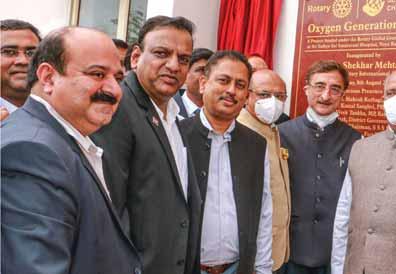
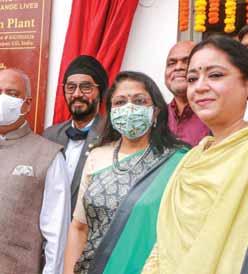
post-operative period. She was frequently extubated and re-intubated, underwent tracheostomy and was eventually weaned off the ventilator.” She was discharged from hospital on Feb 8, but not “before her birthday was celebrated with the entire Sai Family! The father said: ‘We really
don’t have the heart to go home; the love we found here, we can’t dream of getting anywhere else’.”
Little Dileshwar is also ready to return home after his heart has been repaired, and his grateful parents, as they receive the certificate, look visibly relieved. His father, Meghnand Makhi is from the notoriously
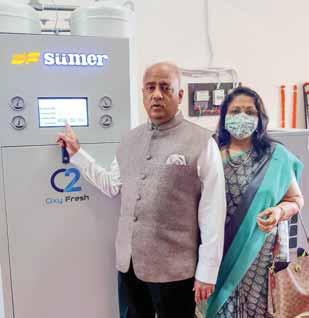
poor belt of Kalahandi in Odisha. He works as a driver and he and his wife were devastated, when they took Dileshwar, now 7 but then only 18 days old, to a doctor when he was running a fever, and were told that the child had a “heart condition”. They were asked to take him to a big hospital; a
Normally a paediatric surgery to repair a CHD costs around `5 lakh, but here it costs only `1.5 lakh. I have compared this hospital with many others that do charitable work, but no centre comes anywhere close.
Mahesh Kotbagi RI Director
relative told them about Sanjeevani, and they brought him here in 2016. Recently he was operated upon and he has started to go to school.
On the role played by Gavaskar, Gour says: “He plays a huge role in raising funds and he is with us because he is a devotee; we have known him from earlier on too. That he is a cricket celebrity is the icing on the cake.”
For the next two centres, these trustees are looking for a city in Eastern UP or Bengal as “we find maximum concentration of children requiring our help in UP, Bengal, Bihar and Jharkhand as the population density is greater there. If we can get some land, these centres can come up.”
Designed by Krishnapratheesh S
At Rotary, we understand that cultivating a diverse, equitable, and inclusive culture is essential to realising our vision of a world where people unite and take action to create lasting change.
We value diversity and celebrate the contributions of people of all backgrounds, across age, ethnicity, race, colour, disability, learning style, religion, faith, socioeconomic status, culture, marital status, languages spoken, sex, sexual orientation, and gender identity as well as differences in ideas, thoughts, values, and beliefs.
Recognising that individuals from certain groups have historically experienced barriers to membership, participation, and leadership, we commit to advancing equity in all aspects of Rotary, including in our community partnerships, so that each person has the necessary access to resources, opportunities, networks, and support to thrive.
We believe that all people hold visible and invisible qualities that inherently make them unique, and we strive to create an inclusive culture where each person knows they are valued and belong.
In line with our value of integrity, we are committed to being honest and transparent about where we are in our DEI journey as an organisation, and to continuing to learn and do better.
Download a copy of Rotary’s commitment to DEI at rotary.org/dei.
Dear Rotary members,
In Rotary, we celebrate diversity, equity, and inclusion. It doesn’t matter who you are, who you love, how you worship, whether you have a disability, or what culture or country you (or your family) are from. All that matters is that you want to take action to create lasting change.
Rotary is working to ensure that everyone sees us as a just and welcoming organisation. Diversity has long been one of our core values, and we’re proud of the organisation we’ve built. But there’s more we can do to exemplify diversity, equity and inclusion (DEI); to expand our ability to reflect the communities we serve; and to respond to our communities’ needs.
Based on input from our DEI Task Force, Rotary International’s Board of Directors strengthened the DEI statement we adopted in 2019. The result is a heightened commitment to diversity, equity, and inclusion focused on celebrating everyone’s contributions, advancing equity, and creating an inclusive culture where each person knows they are valued.
Diversity, equity, and inclusion are not political issues. Each of us has the right to be treated with dignity and respect, to have our voices be heard, and to access the same opportunities to succeed and lead at Rotary. Our members consistently tell us that being a welcoming organisation is vital to our future and that by being diverse and inclusive is how we’ll remain the preeminent place for people of action to connect with one another and make a difference.
We look forward to your continued support as we make Rotary more diverse, equitable and inclusive, ensuring that everyone who engages with Rotary knows they are valued and belong.
Shekhar Mehta RI President, 2021-22
Jennifer Jones RI President, 2022-23
Share our updated statement about Rotary’s commitment to DEI with your members via email or at a club meeting.
Post the updated statement to your club website and social media accounts, and link to it in your club’s email signatures.
Use the statement to discuss how your club can be more diverse, equitable, and inclusive for current and future members.
Encourage your fellow members to be respectful of one another and speak up when a person’s actions don’t reflect our ideals and values.
Expand your knowledge by taking a DEI course in the Learning Center.
Find more resources at rotary.org/dei.

RI President Mehta
Rasheeda Bhagat
RI President Shekhar Mehta spent a good part of August and September visiting seven African countries (Cameroon, Ghana, Nigeria, Ethiopia, Kenya, Uganda and the Ivory Coast), and in each country he made it a point to meet the head of state and discuss the myriad ways in which Rotary could help their local communities, he told Rotary News in an interview.
Excerpts:
As RI president you chose to visit Africa — seven countries — over 20 days. Why so much time and priority for the African continent?
I feel that apart from South Asia, if there is a huge potential for growth in membership, and doing service projects, it is in Africa. I’d never been there but have always believed so. Right from the time service became the mainstay of Rotary, our organisation has thrived in places
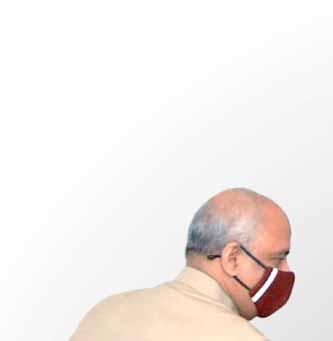

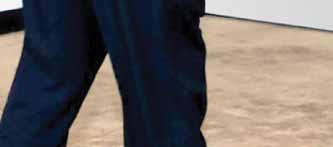




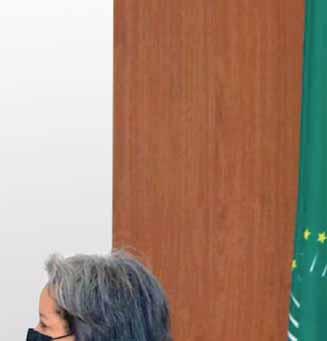
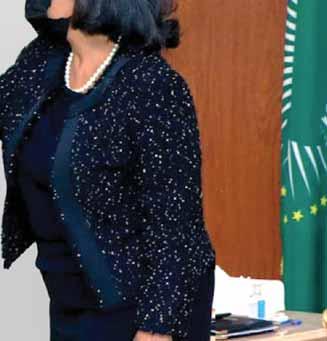


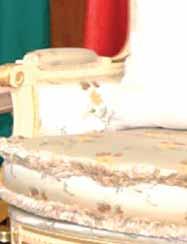
where there is a need for service. In such places, through service projects, we can also showcase the work that Rotary does. If Rotary has thrived in India and rest of South Asia, it is mainly because we can showcase the work that we do and people want to become part of that work through Rotary. But somehow this was not adequately tapped in Africa, so I took the decision to visit Africa, and I wanted to go there earlier rather than later in the year, so that if there are gains to be made in membership these could happen earlier, increasing their impact. And I believe the strategy paid off.
Can you give us an example? We visited the Zone 22 Institute held in Yaounde, the capital of Cameroon; which included 52 of the 54 countries. We saw amazing diversity... around 400 attended physically and 900 attended online. Meeting fellow Rotarians from Africa in person, talking to them, and encouraging them to serve to change lives via Rotary, was very empowering. During our visit, we met 9 out of 17 district

I told the heads of government that I met that apart from buying the vaccines, tell us what you want and we are here to help. Creating awareness is a big challenge, there is so much vaccine hesitancy there.
Clockwise:
RI President Mehta and Rashi with President of Ghana Nana Akufo-Addo.
RI President Mehta and Rashi greet the Prime Minister of the Ivory Coast Patrick Jerome Achi.
With President of Kenya Uhuru Kenyatta.
With President of Nigeria Muhammadu Buhari.
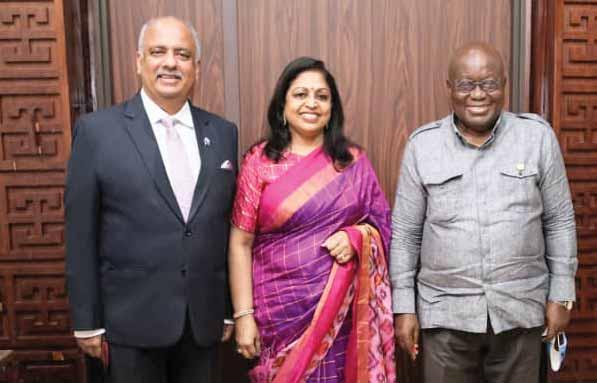
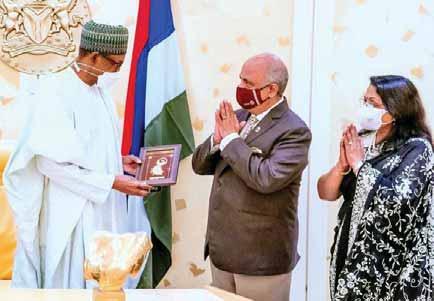
governos. I had requested them to come with their membership chairs. Asked for a membership target, they said they would together do a net gain of 12,000 members. Now there are 17 governors in all in that region, so I extrapolated the numbers and surmised a net gain of 20,000 during this year. Even if that doesn’t happen, I would be happy
I feel Rotary’s importance in people’s eyes will depend on how we position it. And this we need to do at the highest level.
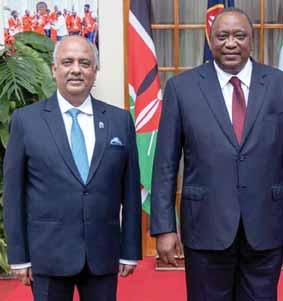
with 15,000, as the earlier estimate given to me was 5,000, which I thought was rather low for a continent as huge as Africa. Now I am certain the net gain in membership will hover around 15,000.
In a social media post you said you were most impressed about 13-yearold girls making reusable sanitary pads in one
project you visited. Tell us more about that, as it is also connected with empowering girls, one of your pet themes for your year as president. Oh yes, I am so happy to note that the programme of empowering girls has caught on so well. Wherever I went, people were so passionate about it and wherever I visited I saw projects

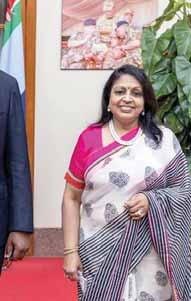
to empower girls in the forefront… whether it was at the Cameroon or the Prague Institute, empowering girls was the main programme. And Rashi and I saw so many projects associated with that.
In Yaounde, Cameroon, we had a chance to see an impactful campaign called Pad-a-Girl. RI District 9141 had organised a
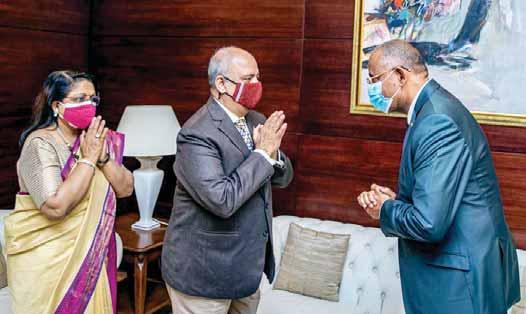
two-day intensive training session for over 500 girls to make reusable sanitary pads. To see girls as young as 13 years old, producing their own sanitary pads was indescribable. We saw these girls in a big hall, and all of them were sewing reusable sanitary pads. And Rashi also sat down with them and stitched a pad. There is a company in this business, and its representatives were training these young girls, supplying the material, monitoring their work and doing quality control. Their objective is to train 2,000 girls, who in turn can further train 20,000.
A single adolescent girl using disposable sanitary pads for two years would cost around $50. But the cost comes down drastically to just $2 for these reusable ones, so there will be a saving of $48 per girl. And look at the benefit to the environment, Rotary’s
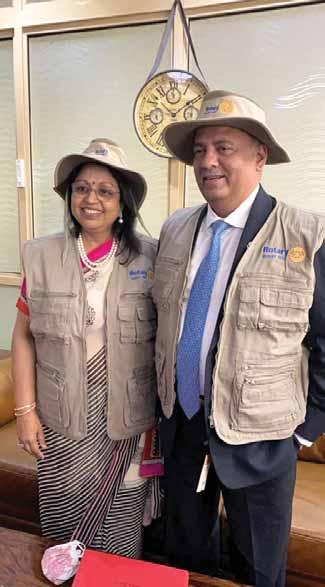
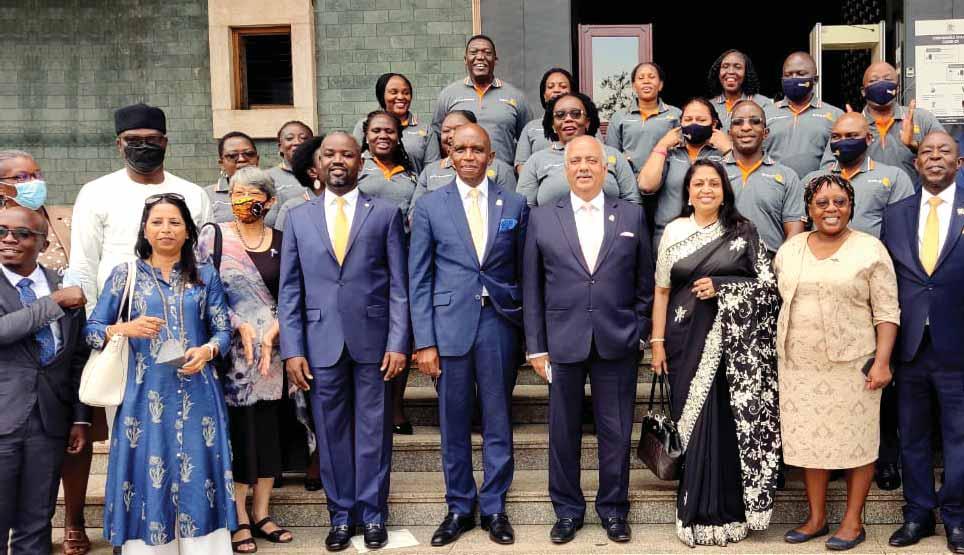
Above: RI President Mehta and Rashi with the government’s chief whip Thomas Tayebwa (fourth from L), DG John Magezi Ndamira (fifth from L) and Rotarians in front of the Parliament of Uganda.
Below: RI President Mehta all set for the #RotaryCancerRun10, a fundraiser organised by RC Uganda. Past RI vice-president Yinka Babalola (L) and DG Ndamira (R) are also seen.
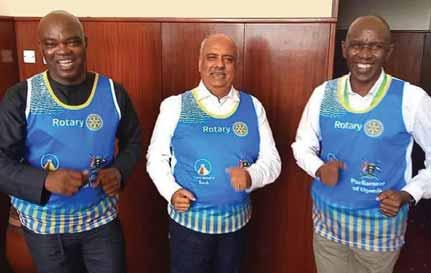
latest and seventh area of focus, by not disposing of pads after a single use. Actually, several of our focus areas get served — environment, empowering girls, health and sanitation. This project really warmed my heart.
What were the other remarkable projects that impressed you? Giving scholarships to girls who formed part of the internally displaced population (IDP), which is a big problem in many regions of Africa, where people are displaced due to terrorist activity. These girls had to move away from their homes in their own country and live in makeshift places. Rotary is helping such girls with their education.
I also attended a huge project on tree plantation in the Ivory Coast and also Kenya, where
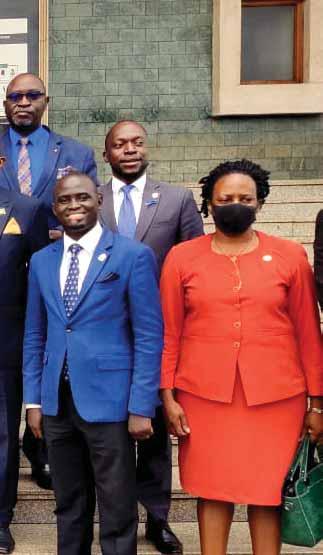
Rotarians are giving 10 million saplings.
One of your major discussions with the heads of state you met was regarding Rotary’s help in vaccinating people. But isn’t the biggest challenge faced by African countries related to inequitable access to Covid vaccine?
We are clear about one thing; we’re not getting into the area of procuring
vaccines, because that will mean buying the vaccines. RI has taken the decision that our eyes are still on polio eradication and we are not going to buy Covid vaccines.
So I was clear on this aspect when I met heads of government… I told them apart from buying the vaccines, tell us what you want and we are here to help. Creating awareness is a big challenge, there is so much vaccine hesitancy there. People simply don’t want to take vaccines. In Cameroon, the general feeling, including among some Rotarians, was that we won’t get Covid, as we take such strong
herbs, and so on. Maybe their internal immune system is better or whatever the reason, the incidence of Covid is so much lower in those countries compared to what we find in the US or India… far fewer people are being infected or dying due to Covid there.
So I told them that Rotarians are prepared to give all help related to vaccination, maintaining the cold chain, raising awareness, etc.
On what other areas do Rotarians need to focus in Africa?
Africa is the jewel in the crown of Rotary. It just needs to be polished
Everywhere, I, as the RI president, got the honour that is reserved for a head of state. It was so great to see that Rotary is so mature in Africa, has an excellent profile and great connectivity.
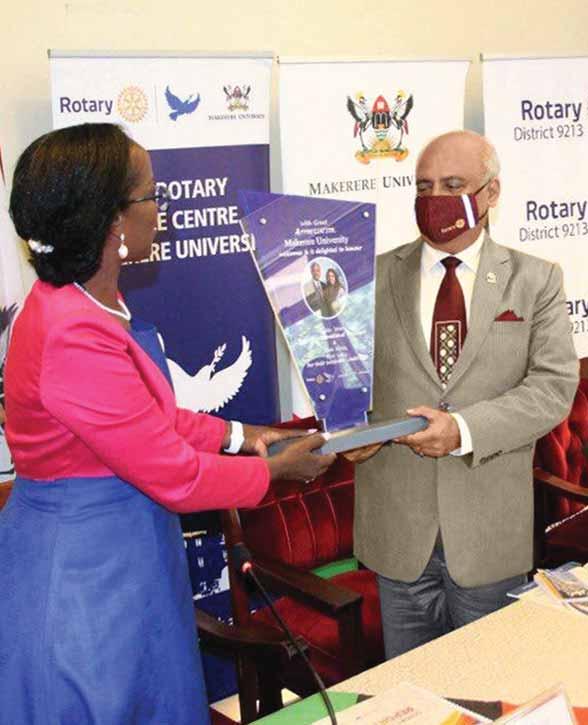
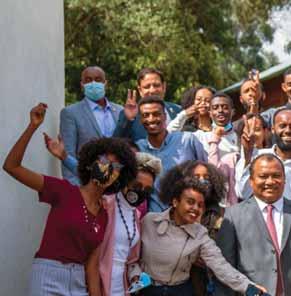
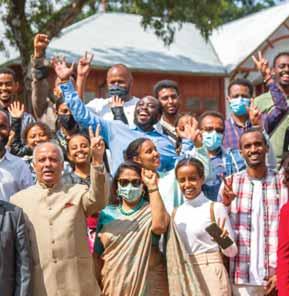
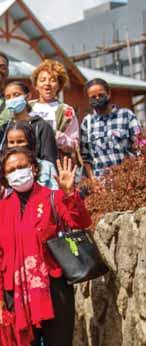
Above: RI President Mehta and Rashi with Rotaractors in Ethiopia; Below: with PRIP Holger Knaack (second from L) at a multi-zone Institute in Prague, Czech Republic; Above right: at a TRF Donors Recognition Dinner in Ethiopia.
a little and the Rotary leadership has to go there to polish this jewel. I’m happy I went there and I am going to visit Africa two more times during my presidential year; one for the presidential conference in Mozambique in March 2022 and before that, I’d like to visit North Africa — countries such as Egypt, Morocco, Tunisia, as the membership is higher in those parts of Africa.
Would you like to highlight any other aspect of your African trip?
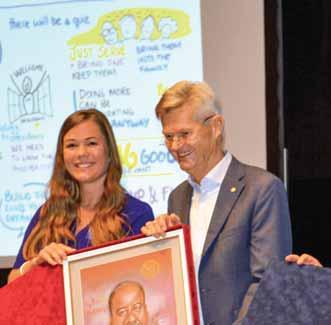
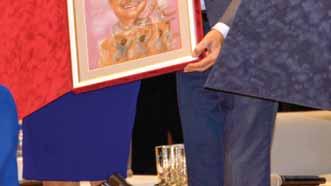


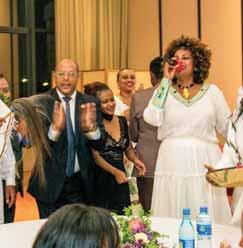

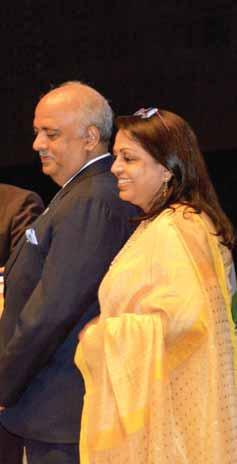

The most important aspect of my trip was that at each of the places I made it a point to meet the president or the prime minister of the country. And that was the highlight, which is very important. I feel Rotary’s importance in people’s eyes will depend on how we position it. It is imperative to position Rotary properly. On one
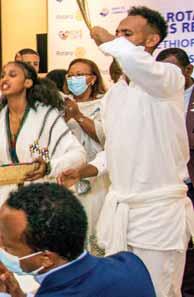

side is the great work we do, and the public image that it creates. Unless we tell our story, nobody will know about Rotary. But that story has to be told at the highest level.
I’ve made it a point to tell Rotary’s story at the highest level; I did it to each of the heads of state I met in Africa. I’d like to reiterate
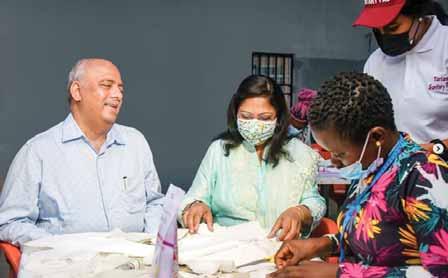
the importance of how we position ourselves. If we do it casually, we will be taken casually. An aura needs to be created. The other important aspect of my visit was that to each of these heads of state, Rotary had something to offer, and not to request or ask.
Can you elaborate?
On behalf of RI, I told the government heads that if you need anything to be done in our areas of focus, we will help you out. For example, the health infrastructure in the African countries I visited is not too great. Prior to my visit, I had found out how many eye hospitals were there in Kenya outside Nairobi. There weren’t many. I told the Kenyan president that we are
ready to set up an eye hospital for you, provided you give us the building. He said how many eye hospitals can you set up? I said as many buildings as you can give us. He said: ‘Mr Mehta before you reach your destination, the buildings will be given.” He said the same for blood banks.
He got up and said can I shake hands with you? Normally I don’t shake hand during Covid times. Now Kenya is doing well in certain parameters compared with some other African countries, but needs are there. Setting up an eye hospital needs two global grants; one to set up and the second to run it for about 18 months.
I know this from experience, having set up so many eye hospitals. Next,
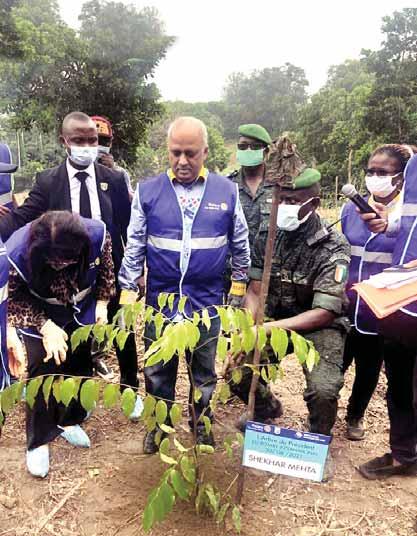
In the Ivory coast, I was pleasantly surprised when just as I started to talk about the literacy programme, the head of state said, “I know all about the TEACH programme.”
I offered the e-learning programme and all of them lapped it up. In the Ivory coast, I was pleasantly surprised when just as I started to talk about the literacy programme, the head of state said, “I know all about the TEACH programme.”
RI President Mehta participating in a tree plantation drive in the Ivory Coast.
We have already made some e-learning content for a pilot project in Togo, where the content is translated into French, and the images are substituted with African pictures. Now that there is so much interest, demand and need, we can send it to Ghana, Kenya, Ethiopia, etc.
I must once again mention the deep interest in programmes to empower girls; the icing on the cake was the resolution passed by the Ugandan Parliament. They invited 23 of us and the resolution talked about the humanitarian work that Rotary has done around the world, and the impact it has made on polio eradication, including in Uganda.
In all countries, I, as the RI president, got the honour that is reserved for a head of state. It was so great to see that Rotary is so mature in Africa, has an excellent profile and great connectivity; 20 of the parliamentarians who go up to speak were Rotarians; at least 30 to 40 MPs in those countries I visited were Rotarians.
Designed by Krishnapratheesh
Kiran Zehra
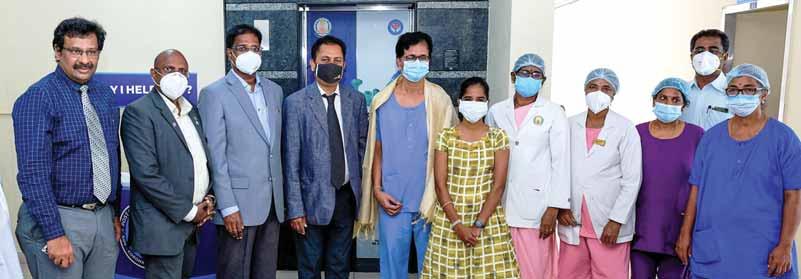
From L: PDG G Olivannan, club president John Fredrick, DG J Sridhar, RID Mahesh Kotbagi and Dr Narayanaswami at the Covid care facility.
During his visit to the post-Covid care centre at the King Institute of Preventive Medicine and Research, Guindy, in Chennai, RID Mahesh Kotbagi felicitated seven Rotarians from RC Madras North, RID 3232, for their contributions towards Covid relief projects undertaken by the club. He, along with DG J Sridhar, PDG G Olivannan and club president John Fredrick, visited the Covid facility where the club has installed oxygen concentrators and medical equipment worth ` 1 crore. Appreciating the club’s efforts, Kotbagi noted that this project was in tune with RI President Shekhar Mehta’s mantra of ‘thinking and doing big’. The club stepped forward at a “very crucial time and worked with extraordinary pace in
helping the underprivileged people of Chennai.”
He also met the director of the Covid centre Dr Narayanaswami and his team and assured him that
Organisations like Rotary have played a vital role in equipping hospitals and supporting healthcare workers so that they can provide quick help to those in need.
Dr Narayanaswami Director
Covid-care centre, King Institute
if they required anything “Rotary will be there to help you.” Calling the doctors and the medical staff the “real heroes”, Kotbagi said “the sacrifices you are making for the safety and welfare of humanity is priceless and deserves lifelong gratitude.” Thanking the RI director, Dr Narayanaswami said while the deadly virus has brought out the inadequacies in the healthcare systems across the globe, “organisations like Rotary have played a vital role in equipping hospitals and supporting healthcare workers so that they can provide quick help to those in need.” DG Sridhar said the members of the club have proved that Rotarians are people of action by extending timely help to the healthcare workers in responding to the pandemic on a war-footing.
Iam fortunate that 35 years ago someone gave me the gift of a Rotary membership and I was happy to have extended the same gift to many,” said RI President Shekhar Mehta in an online membership chat attended by Rotarians and non-Rotarians world over. Many non-Rotarians even expressed interest in becoming Rotary members. RI Director Vicki Puliz, Membership Committee chair Kamal Sanghvi and vice chair Jeris Gaston also participated in the event.
The pandemic has increased community needs and so this is the right time to grow Rotary and do more. This year Rotary is placing special emphasis and taking aggressive steps to bring in more members by asking each Rotarian to introduce at least one member to Rotary through the
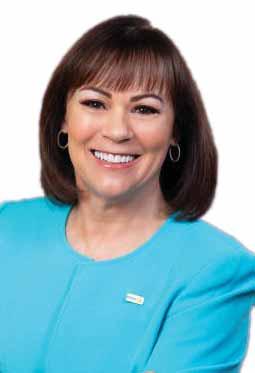


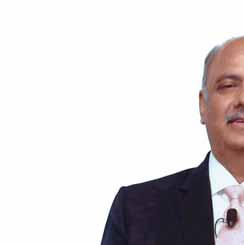
Each One Bring One (EOBO) scheme, said Mehta. “Let’s share our stories by organising ‘Rotary Days of Service’ to showcase the great work that we do in various fields and inspire more members to join in the good work we do. Even as we include new members, diversity, equity and inclusion is going to be the mainstay,” he added.

ne h ta. “Let’s y f Service’ reat work ous members work we clude new i ty , eq u i ty ingtobethe
The RI President anchored a Q&A session with the three participants to provide more clarity to EOBO’s goals.
Mehta: What does the ‘Grow Rotary’ initiative mean to you and why do you feel it is vital to the growth of our organisation?
Vicki : The initiative is exciting because all of us will be reaching out to people we know and respect, and who share our core values of friendship, integrity, diversity, service and leadership. We will invite them to be part of Rotary, so that they can be part of something greater than themselves, and create lasting change.
Another important aspect of this initiative is the chartering of new and innovative clubs that offer more flexibility for their members. We have international e-clubs that are formed with groups of people who enjoy the same activity and are passionate about a particular cause. Fully engaging the members and giving them value

of their Rotary experience, directly involving each member to bring one new member to Rotary and starting new innovative Rotary/Rotaract clubs to meet changing needs are the ways to grow Rotary and increase our impact.
Sanghvi : If we want to expand our reach or impact, we must have more members. Our clubs will become more vibrant and we will have more resources to help the communities to flourish. Membership is Rotary’s internal organisational priority. Somebody touched us and brought us into this fantastic world of Rotary. We enjoy the joy of giving and the blessings of millions of people. Now it is our time to go out there and touch somebody else and bring him/her into Rotary.
Mehta: What has this gift meant to you? Can you share a personal story of how you extended this gift to someone else?
Jeris: I am thankful for this gift given to me many years ago through an Ambassadorial scholarship. It helped


me expand my world view and see Rotary on an international scale.
Vicki : I joined Rotary for business connections. When I got involved, I learnt that there is so much more. First of all, it is the friendship with people whom I would have not known otherwise. I also gained skills by working with people. And then, there is the incredible gift of doing service. What is unique about Rotary is that our members make the decision as to what is most relevant and important in a community and work with other members to exchange ideas and take action.
My husband Tim initially had access to Rotary through me to many of its benefits such as fellowship and service. But now, he is a member of the Rotary e-Club of Aviation which brings individuals who have a passion for flying together from around the world. Use of technology and Rotary’s flexibility allows this club to connect different people from different countries and backgrounds to develop relationships and friendships to share a common interest and to do good in the world through the Foundation and their club.
One more story involves a young man who had a transformational leadership experience in a RYLA when he was in high school. And now, he is exploring options to join a Rotary club. This is a reminder of the beneficiaries and alumni of our Rotary programmes.
Membership Committee vice-chair
Jeris Gaston
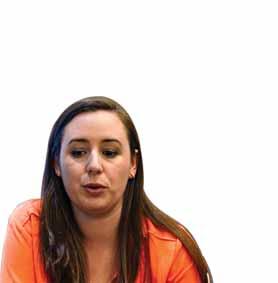

Mehta: Can you give some examples of programmes that Rotary can hold to bring in members?
Sanghvi: While Covid hit a small town, Erode, in RI District 3203, its members got together to build a 400-bed hospital worth $2.75 million in 45 days. The project attracted many local people to join Rotary. And on the World Yoga Day, Rotary partnered with the Art of Living. Both the organisations, with their huge membership base, performed yogasanas online for seven days and 10,000 people participated in the yoga celebrations through various social media channels. This brought in new members to Rotary from across the country. Another idea is to organise youth festivals such as marathons, walkathons, sports competitions to excite youngsters to join Rotary.
Jeris: As a former Rotaractor, I suggest a joint event with Rotaractors to make an impact in communities. Rotaractors want leadership and mentorship and look forward to working with Rotarians. This will also help Rotarians to make a connection with the younger generation and bring in new members (dual members) to their club.

Mehta: Why is equity and inclusion vital for Rotary to attract members?
Vicki: Diversity has a stronger meaning in this age. Bringing together individuals from different professions and places, gender, ethnicity and age can bring together diverse perspectives for clubs. Each club has the opportunity to assess if their members are reflective of their communities and determine what actions they can take which can be welcoming and inclusive to all. EOBO is a perfect way for our members to reach out to people who may not have even considered or even been aware of Rotary in the past.

Membership Committee chair PRID Kamal Sanghvi
Jeris: We must bring in the next generation of Rotarians to continue service. When we have clubs that are diverse and inclusive, we will have a stronger Rotary and can do more together.
Sanghvi: The fact that we are in 200 countries across the world shows the relevance of diversity and equity in our organisation. We also understand in Rotary that cultivating a diverse inclusive culture is essential to realising Rotary’s vision of a world where people unite and take action to create lasting change. We value the contribution of people across all ages, ethnicity and caste, religion, culture, languages, sexual orientation and gender identity and also, differences in ideas and thoughts. An organisation is only good as long as its members are united. We do not want barriers and each and every club hears the needs of a community irrespective of any differences. We need to encourage women to join Rotary as 48 per cent of the world’s population is women. They are the leaders of the world. Every person in the world holds a visible and invisible quality which can make an organisation unique.
to be the need
Rasheeda Bhagat
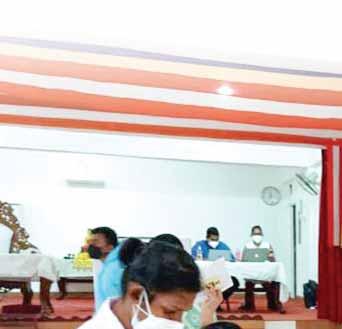
PRIP K R Ravindran with DGN Pubudu de Zoysa (RI District 3220) at a vaccination booth organised by RC Colombo.
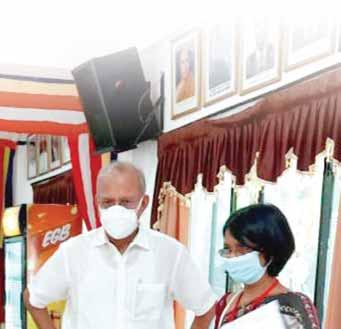
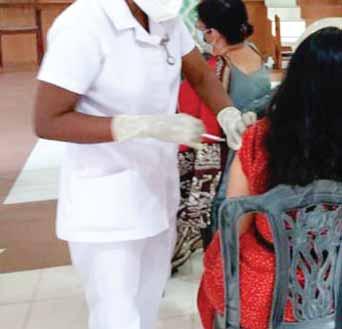
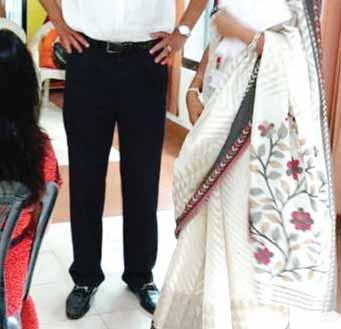


With inequitable access to the Covid vaccine in different countries, and countries such as Israel and UK registering a surge of cases in variants of the virus, pandemic challenges remain, says PRIP KR Ravindran, chairman of the RI Covid Task Force in an interview to Rotary News. Excerpts...
You are chairing the RI Covid Task Force; how does it work and what are its priorities?
The Covid pandemic interrupted Rotary activities as never before; last year a committee was formed consisting of top TRF and RI leaders — Holger Knaack, Shekhar Mehta, Jennifer Jones, John Germ, Ian Riseley and me. It met on a regular basis but given the other responsibilities of each member, it faced a handicap. So early this Rotary year, a new committee (of which I am the chair) was formed with knowledgeable individuals (some of them experts) with global representation. The committee is styled similar to the International PolioPlus Committee.

As for priorities, it will broadly focus on the following:
Providing support and direction to Rotarians on speedy and best response to the Covid-19 crisis. Assisting in the development of relationships and seeking funding from outside foundations and international development organisations to fully utilise Rotary’s ability to advocate for Covid-19 vaccination as demonstrated by our work in eradicating polio.
The current international vaccine access is uneven, and mitigation of that gap is crucial. No country is safe unless all the countries are safe.
Advise the RI board and trustees on the safety of travel and meetings around the world.
The committee members are required to report on the following:
Trend of Covid positive cases in their region for both adults and children
Incidence of breakthrough cases (fully vaccinated persons being infected)
Government position on travel and restrictions
Vaccine availability
Key challenges/noteworthy events.
What kind of impact has Rotary made internationally vis-à-vis this pandemic?
We have actively endorsed the call of UN Secretary-General Antonio Guterres to the G20 nations to assure vaccine equity worldwide. We have also communicated with the president of the 2021 G20 summit, Mario Draghi, PM of Italy, stating that while we appreciate the G20’s Rome declaration indicating “support for global sharing of affordable vaccine doses, when domestic situations permit,” that assurance, just by itself, is not good enough. And that the G20 has an obligation to ensure that every country is in a position to obtain its required stock of Covid vaccines in a timely way. We recently signed an MoU with GAVI (Global Alliance for Vaccines and Immunisation) confirming a collaborative arrangement globally, to further Covid-19 vaccine coverage through social realisation advocacy.
GAVI is a global public and private sector vaccine alliance, with the
shared goal of ensuring equitable use of vaccines and is co-leading the Covid-19 Vaccines Global Access, (COVAX), as a worldwide initiative, aimed at making sure every country has access to Covid vaccines.
The COVAX initiative is directed by GAVI and partnered by WHO, UNICEF and CEPI. Rotary and GAVI have come to an agreement in principle to work together towards the vision of “One World Protected against Covid.”
We have agreed that the current international vaccine access is uneven, and mitigation of that gap is crucial. No country is safe unless all the countries are safe and only vaccinating the whole world will determine the course of the pandemic. The more people get vaccinated, the less transmission occurs in the community, reducing everyone’s risk of infection.
In many countries Rotarians could use the experience gained through our polio efforts to support COVAX in the delivery of the vaccines and in other ways. To begin with, GAVI/ COVAX has shortlisted 9 countries, including India, Pakistan, Bangladesh, Nepal and Sri Lanka, for a more active partnership.
There is always a question mark on the numbers given out by governments. Would you agree with the given statistic that only 4.5 million people around the world have succumbed to this virus? What is your estimate?
I don’t think these figures are correct and there is a huge underreporting. The Economist magazine states in its September issue that its single best estimate of the actual world death toll is around 15.2 million people. Their studies indicate a 95 per cent chance that the true figure is between 9.3 million and 18.1 million additional deaths. This number is the gap between how many people died in a given region
during a given time period, regardless of cause, and how many deaths would have occurred in the normal course if a particular circumstance (such as a natural disaster or disease outbreak) had not occurred.
That, I think, is a reasonable way of calculating the actual toll.
What do you think are the most stringent challenges the world faces in its efforts to eradicate this virus?
Scientists have come up with several Covid vaccines in a record time. Manufacturing the lifesaving shots has been another huge achievement. Output is forecast to surpass 12 billion doses by the end of the year and could double again by mid-2022.
Unfortunately, the problem we face is inequitable vaccine supplies; only a fifth of people in lower-income countries have received the first dose, compared to 80 per cent in higherincome nations.
What about the resistance to vaccination in some countries, including India?
That’s the other problem; the strong anti-vaccine lobby. It is here that Rotary can play a major role in combating such views. Over 99 per cent of Covid deaths in June occurred in the unvaccinated. Yet, despite growing evidence that vaccines are safe and effective, resistance to them continues to grow in some

quarters. The slow rollout of vaccines in most African countries poses the danger of the virus replicating and new, more dangerous variants emerging and spreading around the globe.
Rotarians world over can play a major role in explaining that vaccines are safe, and tell people where we reached because we vaccinated children against polio. Once there were 1,000 cases a day globally; today we have just 2 wild poliovirus cases across the globe.
large numbers without observing strict pandemic protocol.
The CDC recently issued a warning that even fully-vaccinated persons should take precautions. Research confirms Covid outbreak risk at camps and large events where prevention strategies are not implemented adequately.
Rotarians can play a major role in explaining that vaccines are safe, and tell people where we reached because we vaccinated children against polio.
We can lobby that vaccination should be made compulsory for everyone who wants to travel in an airplane, train or bus, attend a movie, eat at a restaurant, shop at a store, work in an office or visit any other indoor space.
From Sep 1, in Sri Lanka, no unvaccinated person is being allowed.
When do you think Rotary clubs can start meeting again physically? I am neither an expert nor a fortuneteller!Virus variants are tearing through places where people gather in
I would discourage any large indoor event for sure. Recent reports show that 12–24 per cent of people hospitalised for Covid are fullyvaccinated. We know that the delta variant has surged in the highlyvaccinated Israel, and that in the UK, the majority of recent deaths have been among the vaccinated.
Things may change in a few months, but if we must have meetings, club or district, they should ensure the room is well-ventilated.
During the Crimean war Florence Nightingale settled on the principle that would later prove key to her legendary nursing career: the importance of opening windows to ensure an inflow of fresh air.

119,784 14,609 23,850 10,648 2,065 23,973 66,657 7,196 8,283 5,862 6,369 177 2,473
12,008 22,034 30,964 2,428 1,766 33,495 21,569 150,968 1,619 3,800 5,420 8,574 114,263 13,906 2,496 2,447 1,643 36,770 1,538,813
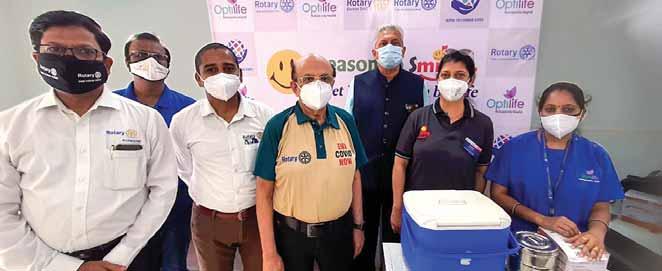
What is the main focus of the India Covid task force that you chair?
Chairman of the Rotary India Covid Task Force, past RI Director Ashok Mahajan, says support from senior RI leaders and an enthusiastic and hardworking district and club leadership in Rotary in India, has helped to vaccinate over 2 million Indians against Covid. He is confident that India will walk free from Covid very soon.
Excerpts...
When the Government of India was preparing to roll out the Covid vaccine, Rotary leadership in India quickly offered to partner it in Covid vaccination, and I was invited to chair the Rotary India Covid Task Force. Further to meetings with officials from the Union Health Ministry and Niti Aayog, the following focus areas were identified:
* Creating awareness on the Covid vaccine
*Social mobilisation
*Overcoming pockets of public resistance caused by misinformation
*Providing logistical support where required.
What role has Indian Rotarians played in Covid vaccination; can we have an estimate of the numbers?
Rotary clubs all over India have played a huge role in the Covid vaccination
drive. They started out by organising rallies and online seminars and made great use of social media to promote vaccination. Once the drive started, Rotary clubs have helped in providing cold chain, transport for the vaccine, and organised vaccination camps across the country. By my estimate, close to 2 million Indians have been vaccinated at camps organised by Rotary clubs.
Besides this, Rotarians have also helped augment Covid hospitals’ capacity and provided oxygen concentrators to various hospitals, installed oxygen plants, provided medicines to the needy, managed call centres to provide information about the availability of beds, oxygen concentrators, medicines, etc.
What are the main challenges that India faces in getting its population vaccinated given our huge
population? What more can Rotary do to help?
The first hurdle was getting sufficient supplies of the vaccine as our sheer numbers are quite overwhelming. After all, ours is a huge population, which is densely concentrated in cities. With over half the population having got at least one jab of the vaccine, and lockdown being phased out, the challenge lies in ensuring that people do not let their guard down. Maintaining sufficient physical distancing, avoiding physical meetings and using face masks and sanitisers must continue.
Rotary clubs must also help the state governments in ensuring that people in rural areas get their vaccination at the earliest.
You played a huge role in Rotary’s efforts in helping to eradicate polio
from India. Do you find any similarities or differences in the Covid vaccination drive?
Polio vaccination had encountered resistance from certain pockets of the Muslim community. We overcame that by enlisting the support of religious leaders who convinced their flock to accept the vaccination. This was a tipping point in the polio eradication drive which finally led to India being declared polio-free.
This time around, the Ulema Committee, of which I am still chairman, was brought on board very early to ensure that Covid vaccination did not meet any resistance from the Muslim community.
One challenge is that the polio vaccine had to be given only to children below the age of 5. Covid

vaccine needs to be administered to every adult Indian. That is a staggering figure, and our government has done a tremendous job so far.
But we have some way to go before we can breathe easy again. However, Rotary’s experience in polio vaccination gives us the confidence that India will walk free from Covid very soon.
It will not be out of place here to mention that the entire Covid task force is dedicated to the cause and is fully supported by our senior RI leaders. The district and club leadership is doing tremendous work in assisting the local governments to get rid of this dreadful virus. God willing, we will succeed in making India Covid-free soon.
Rotary Club of Hubli Vidyanagar, RID 3170, donated handcarts with storage boxes to underprivileged women. They can use these mobile carts to sell vegetables, fruits, wares or food items and earn a living, said club president Dr Mahima Dand.
In another inititative, the club organised a menstrual hygiene management programme for the students of the IBMR College in Hubli, as part of the club’s RED project. Menstrual cups were distributed to 100 students and lecturers. An awareness lecture was presented to educate the girls about the safety and hygiene of using menstrual cups and reusable sanitary napkins instead of disposable ones.
Rasheeda Bhagat
The series of lockdowns caused by the Covid pandemic across India has left debilitating and far-reaching implications for the handloom industry. Not only has the weaving of fabric almost come to a standstill, the supply chain from the weaver to the agent to the shop has
biggest fear staring these artisans in the face is that even when the supply chain is restored and shops and stores open as they have already started doing, will the consumers show enough appetite to buy the beautiful fabrics that they have woven.
between, have taken a really drastic beating, and this includes the weavers in Chhattisgarh who weave the beautiful kosa silk sarees. Kosa is the Sanskrit word meaning ‘silk’.
Chhattisgarh, was quoted thus: “More than 25 handloom weavers who work for me have not had any work since the lockdown began. I don’t have raw material to give them.”
Kosa is often described as a kind of tussar silk, but it can often be different from tussar, being a little rougher in texture and lacking the shine of tussar, explains Archna Agarwal, president of Rotary Club of Bilaspur Queens, RID 3261, an all women’s club with 38 members. She has conceived and launched a project to help several families, particularly also been disrupted. The and in silk in Raigarh district, families,
The silk weavers of India, from Kashmir to Kancheepuram and in

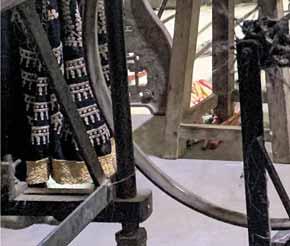
In a recent article in The Print, Kanhaiya Dewangan, a master weaver and trader of kosa
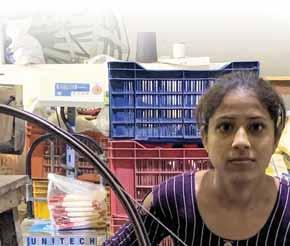
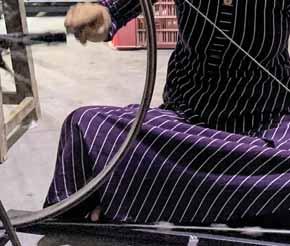

women, engaged in weaving kosa silk. Aptly, and rather poetically, titled Sapno ke dhaage (dream threads), this project envisages helping the weavers and their families in a myriad ways,
Kosa silk occupies the pride of place in every Chhattisgarh home, and adorns women’s wardrobes across India.
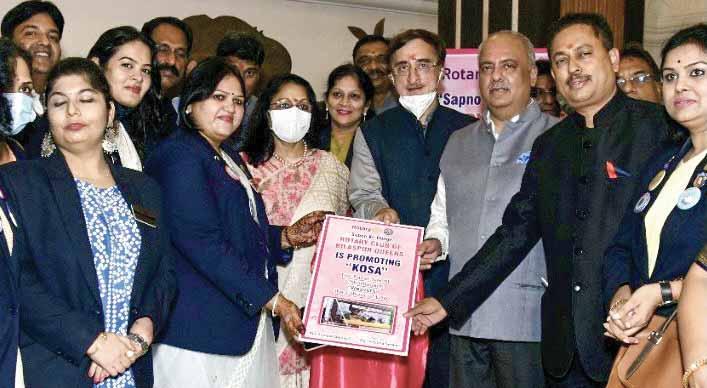

particularly in the brutal aftermath of the Covid pandemic.
lparticular af a te t rmath p pandemic Archn y l almo m st a n de deli l berati f an impactf
g wi w ll chang pe p ople. In j se s le l ct pro c a service i it, but duri
n as a preside u to t carry o
d w inclu M Sh S ekhar
m area e of em y wo w men h and then their ware
Archna says that for almost a year she has been deliberating “on doing an impactful project that will change the lives of people. In Rotary we all select projects that have a service component in it, but during my year as president, I wanted to carry out work which will include RI President Shekhar Mehta’s focus area of empowering girls/ women by skilling them, and then helping to market their ware in a very tough environment,” she says.
which was inaugurated by President Mehta before he left for the RI headquarters in Evanston in August.
The fulcrum of this project will be Umreli, about two hours’ drive from Bilaspur, “because after a lot of research and visiting the area I found both talent and great need among the women here. Many of the girls and women can’t go outside the house, they are not
e e envi v ronm g
r thhe e weaver
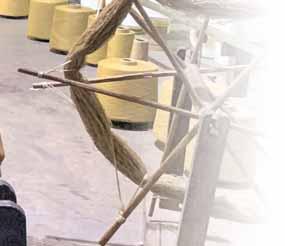
o wh w ich is s e transforme
n g grac a eful a t sarees tha n of o i

w w women’s club lau c cllub u launc
Seeing the plight of the weavers of kosa silk, which is so beautifully transformed into the graceful and elegant sarees that occupy a pride of place in many Indian women’s wardrobes, the club launched this project
Kosa is often described as a kind of tussar silk, but it can often be different from tussar, being a little rougher in texture and lacking the shine of tussar.
educated and are totally dependent on their husbands or fathers. And if you consider the fact that these talented kosa silk weavers are the shaan of Chhattisgarh, I thought we have to promote their welfare,” says Archna. On the difference between tussar and kosa silk sarees, she says that while tussar has a light shine, kosa is rougher in texture, but with a lot more varieties. “The price starts at `6,000 to 7,000 and can go up to `25,000. But the weavers don’t get much. A woman takes 1.5 to 2 days to make one kosa silk saree for which she gets `400–500, but there is no guarantee of work every day.”
Prerana Surana, project chair says, “Kosa silk occupies the pride of place in every Chhattisgarh home. Our
love for handlooms has made the kosa silk cross the nation’s borders and it is highly sought after by designers worldwide.”
She adds, “All of us involved in this project believe that weaving is a great combination of creativity, focus, patience and concentration. It is much beyond making and selling, and the finished saree is really a product resulting from the labour of love.”
The club members were really moved by the fact that so many of the girls who weave these sarees expressed their desire to improve their lives and livelihoods through better education. “One girl said that I want to learn computers. Then there is a family with five
There is both talent and need among these village women. As these talented kosa silk weavers are the shaan of Chhattisgarh, I thought we have to promote their welfare.
Archna Agarwal President, RC Bilaspur Queens
daughters and they are really in need of our help. So I have given them the commitment that we will try to do a big project, maybe through a global grant, and if that comes through, we will help in the marriage of these girls… not only these girls but also other young women,” says Archna, a trained lawyer who also works in real estate. She explains that as theirs is an all-women’s club, big funding from the members is not possible. Her husband, Arun
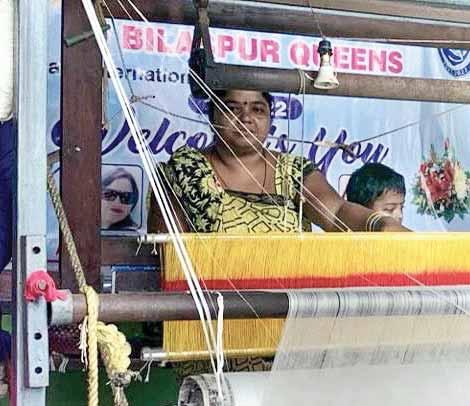
Agarwal, a past president of RC Bilaspur Midtown, is a chartered accountant and she has personally donated `2 lakh for this project. The members also have plans to do a Covid vaccination camp for at least 1,000 people.
On why she became a Rotarian, she says that she was “always involved in Rotary and its activities and projects, first as a spouse and then as a Rotarian myself. I realise that god has given our family both talent and wealth… there is so much need and opportunity for service in our communities, so we should do whatever we can to help.”
When I compliment her on the rather poetic name for the project title, Archna beams and says that while brainstorming on this aspect, “we felt as all the dreams of these
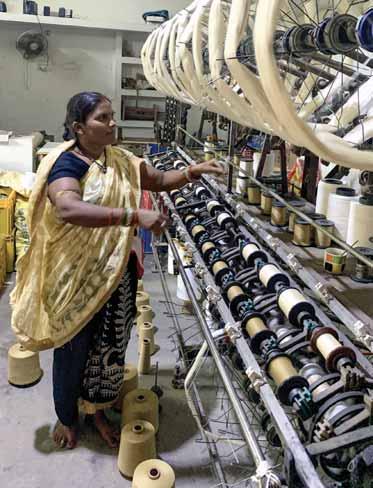

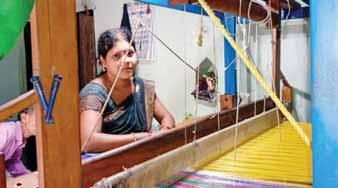
women are related to weaving, this would be an appropriate title.”
On the road ahead, Prerana says that the club members are now creating an online platform for these women to help them market their ware at a better price. “We will set
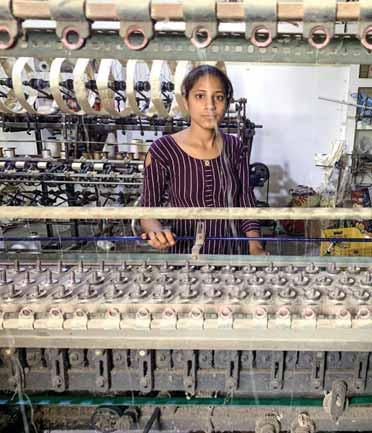
up a website called www. sapnokedhaage.com; our plans also include three centres in three villages, including Churi and Shivni, and as the girls want digital literacy, we will put five computers in each centre, apart from sewing and embroidery
We believe that weaving is a great combination of creativity, focus, patience and concentration. It is much beyond making and selling, and the finished saree is really a product resulting from the labour of love.
Prerana Surana Project Chair
machines. Classes will be organised in tailoring and embroidery so that they can increase their product line and get more income.” A crafts mela or exhibition is also being planned to market these sarees.
Adds Archna, “We will hire a tutor to give them digital literacy, hold adult literacy classes through the TEACH component of RILM, and also give basic education to their children, so that they don’t lose hope in their future.”
The club also has plans to establish a small financial entity from which loans for tiny self-enterprises can be given to the women.
“We have so many plans and want to apply for a `20–30 lakh global grant to improve the lives of these families, and empower the women.”
The inspiration to make this a “bigger and bolder project” came from RI President Mehta, when he inaugurated it on the National Handloom Day in August, with Rashi Mehta, RID Mahesh Kotbagi, RI Membership Committee chair Kamal Sanghvi and DG Sunil Phatak (RID 3261) and PDG and Member of Parliament Vivek Tankha, adds Archna.
Designed by Krishnapratheesh
As the hills went in for a stringent lockdown during the first and second waves of the Covid pandemic, members of Rotary Club of Kodaikanal, RID 3000, got into action and did a clutch of community service projects targeted at relieving the distress of the local community.
As immediate past president of the club Kripa Soans points out, “Kodaikanal, being a tourist town, was terribly affected as everything shut down due to Covid. Without tourism there is virtually no livelihood here.” The 50-odd Rotarians of this prestigious, 48-year-old club started giving grocery kits to all those who were heavily dependent on business from tourism… taxi drivers, shopkeepers, fruit and
Kodaikanal, being a tourist town, was terribly affected as everything shut down due to Covid. Without tourism there is virtually no livelihood here.
Kripa Soans
immediate PP, RC Kodaikanal
Rasheeda Bhagat
vegetable vendors, workers in hotels and restaurants, etc.
In no time it became a very big project. “I don’t know how the money came in, but it did come and for a long time we gave lots and lots of food to the local people. In the first phase, food kits worth about `14 lakh were distributed for four months, and we gave food to some 2,500 people at the peak of the pandemic when tourism had totally stopped and the hills were
From L: Former club secretary Jaswanth, club president G Bala, past presidents Selvakumar and Kripa Soans.
locked down.” Totally, the members of RC Kodai raised and spent `1.13 crore to provide relief to the local community during the pandemic.
Next, right from March onwards, the members embraced vaccination against Covid, “and forged a firm partnership with the government. Thanks to this partnership, we are proud to say that the entire population of Kodai has been vaccinated against this virus,” says Kripa.
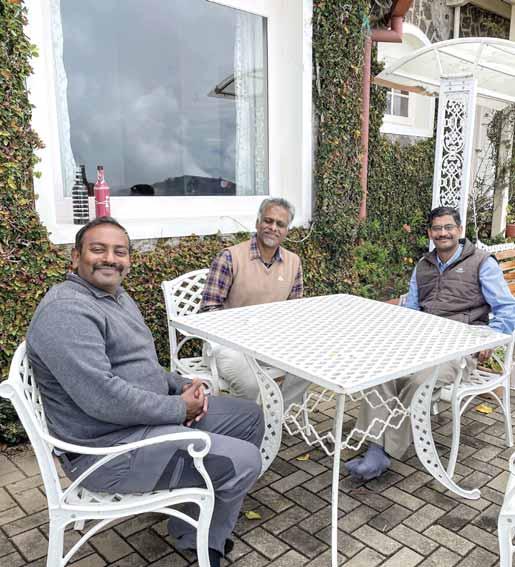
In between, she adds, “we had four months to breathe and had fellowship and some events and then the second wave, much worse than the first, hit us. And once again we got involved in service.”
For this year, says club president G Bala, the focus is mainly on conserving the environment, Rotary’s seventh focus area. A passionate environmentalist, Bala has been an integral part of the Palani Hills Conservation Council since its inception in 1985, and this writer vividly remembers interviewing him along with the other council members in the 1990s and writing a series of articles in The Indian Express , focusing on the dangerous degradation in the hills due to indiscriminate activities
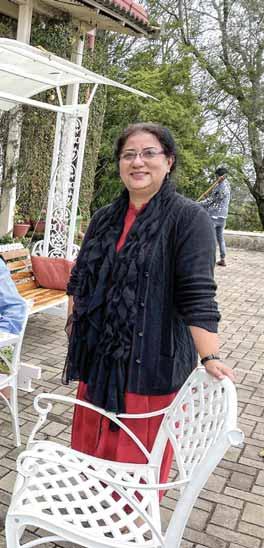
which were having an adverse effect on the delicate ecology in the region.
“This year, our club’s main projects will be the restoration of the Kodai lake, river management and stream studies. The Kodai lake has been badly affected by tourism and we have to ensure that fresh water gets into to the lake.”
He adds that the club also wants to do restoration work on the Pambar river. “Another project of the club this year will be to protect the Gymkhana marsh which is like a sponge for the Kodai lake,” explains past president Selvakumar. Kodai lake has a fencing all around it, but the marsh, unfortunately, is open, and apart from encroachments, building material is also being dumped into the marsh.
“So our Rotary club has planned to take up fencing all around the marsh and provide a nice and thick green cover of trees on the boundaries,” adds Bala. The project, which involves about 2 km of fencing, will cost around `40 lakh.
“For the local environment this is very important; we have already conducted studies, collected data and have a firm plan, but we need government permission for which we have already submitted the application to the district collector,” he adds.
Kripa adds that the club members have been feeding around 37 kids in a tribal village called Perangadu that the club had adopted three years ago. For some reason these children have been left out of the government’s noon meal programme. So we raise money to provide nutritious noon meals, and it costs us `15,000 a month.”
Assistant governor of RID 3000 and past president of RC Kodaikanal Rajkumar Raman says
This year, our club’s main projects will be restoration of the Kodai lake, river management and stream studies. The Kodai lake has been badly affected by tourism and we have to ensure that fresh water gets into the lake.
G Bala, club president
the club is continuing to focus on the welfare of the tribal communities in the region. During his year as club president (2016–17) “we adopted the tribal hamlet of Vallankulam about 22 km from Kodai. We have been trying to improve healthcare and literacy level there. But the highlight of my year and my dream project was to bring solar electricity to this village, and when they finally got solar power, the villagers were so happy. They said our ancestors have been living here for 250 years, but this is the first time that we have seen electricity in our homes.”
Thanks to the solar power the villagers now do not have to go to another village to charge their mobile phones. “The project cost some `4 lakh, and I funded it in memory of my father who was the headmaster of a government school in Ooty, and 32 families benefited from this work of ours,” says Raman.
He adds that this year RID 3000 DG R Jeyakkan had earmarked some special projects to help tribal villagers in the areas of literacy and environment. “Hence the cleaning up of the Kodai lake is very high on our priority,” he adds.
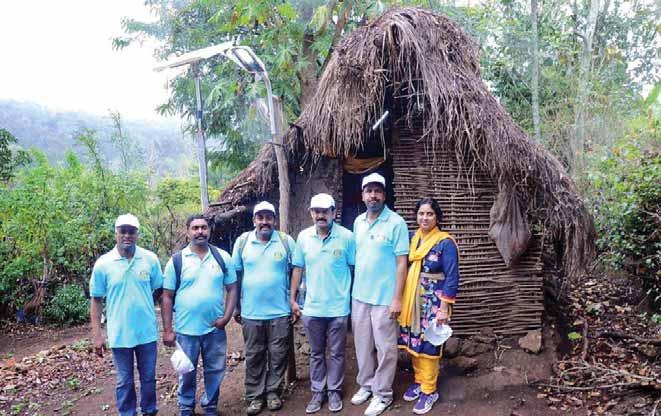
President Bala and Kripa add that as the lockdown exposed the adverse side of the Kodaikanal population
depending primarily on tourism income, the Rotarians are concentrating on improving education levels under the RILM programme and are setting up vocational training courses.
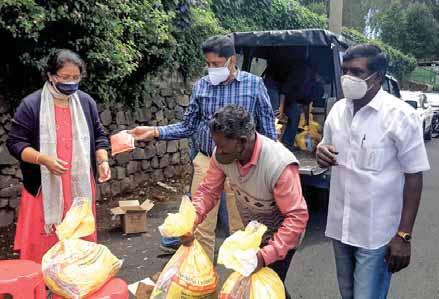
Says Bala, “During the Covid pandemic we realised as never before that almost all the local people are dependent on tourism for their livelihood, hence we have to think of giving them alternatives. So in partnership with the NGO Suraksha Bandhan, which runs a self-help group, we are going to hold tailoring and embroidery classes for women and also provide them marketing support to sell their products.”
Selvakumar adds that in Perangadu, which the club adopted, “so many nice things have started happening. Good roads, water supply and electricity have reached the village with the support of our club.”
Former club secretary Jaswanth says, “We have also built a new classroom there, put up a vocational training centre and also built a shelter for a family that had lost its breadwinner. We’ve also built a bus shelter in Naidupuram, near Oothu.”
In Nashik, dried flowers used in weddings and places of worship are now finding a new use thanks to an initiative of RC Nasik Godavari, RID 3030. The club has installed collection drums at various places for people to drop used or unsold flowers from flower markets or flower farms. These flowers are recycled and used to make eco-friendly incense sticks, dyes and as organic vermicompost.
Nashik is a temple city on the banks of the River Godavari. Devotees flock to these temples with lots of flowers in the form of garlands to be offered to the gods and for pooja rituals. “Hardly anyone gives a thought to what happens to these flowers at the end of the day. Tonnes of used flowers removed from idols and unsold flowers from the market are dumped into the river, polluting it. Pesticides and insecticides used to grow these flowers make the river water highly toxic,” says club president Rakesh Singhal. When club member Dipti Janorkar put forth an idea from the Shirdi Saibaba temple to recycle the huge
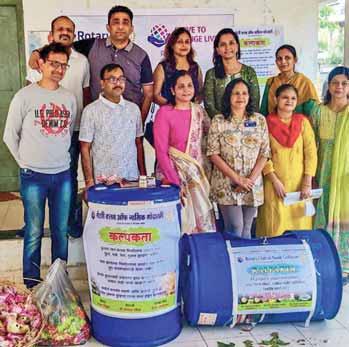
Members of RC Nasik Godavari with collection drums to collect used flowers.
quantity of flowers the club eagerly accepted it. “Dipti had visited their flower processing unit during her visit to Shirdi. The Saibaba temple gets at least 800kg of flowers daily as obeisance from devotees,” says Singhal.
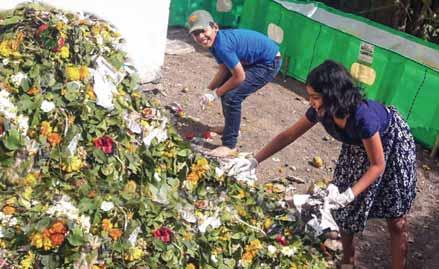
Children separate papers and other waste from the flowers.
The club has employed few women to segregate the collected flowers. “They separate the petals from the flowers which are then sundried and powdered, and used to make charcoal-free agarbattis, dhoop and dyes. The stalks and the not-so-fresh flowers are collected in composters to make vermin compost.”
All the produce from the recycled flowers is sold in the market and the money generated is used to meet the project expenses, including paying the women engaged in this activity, says the club president. “This project also benefits marginalised women, giving them not only a financial benefit but also dignity and respect. At the same time, the environment benefits too,” he smiles.
The club is all set to scale up this initiative, by including nearby villages soon.
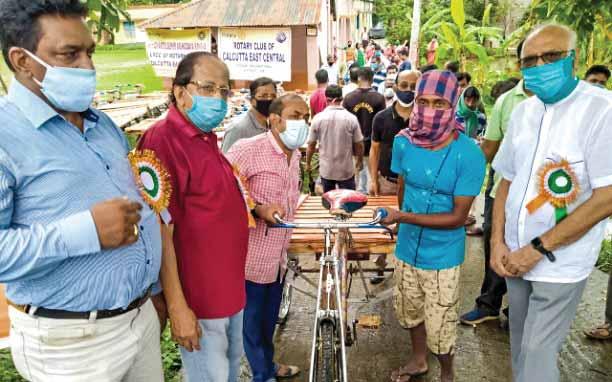
Rotary Club of Calcutta East Central, RID 3291, distributed cycle vans to 20 men and sewing machines to 10 women at the Karanjali gram panchayat in South 24 Parganas. The beneficiaries were identified by the club’s RCC Chakdulalpur Arunoday Sangha and the project, titled Swanirbhar, was supported by a district grant.
PDG Mukul Sinha presided over the distribution event.
Rotary Club of Salem Cosmos, RID 2982, has installed a 6-kilolitre cryogenic oxygen tank worth `30 lakh at the Salem government medical college hospital. The funds required to set up this facility was raised in a record 70 days under the leadership of club president Dr C Sugavanam and was inaugurated by Tamil Nadu health minister M Subramanian.
The lifespan of the tower is 30 years and it will provide high quality oxygen to 350 patients. The facility is a boon to the hospital which was reeling under heavy
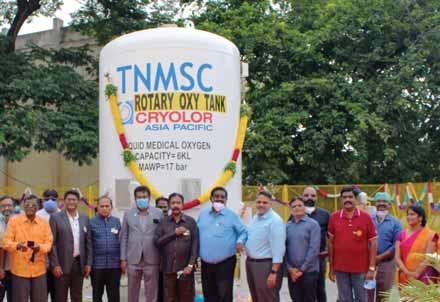
From L: Rtns V Gupta, Arun, club president Dr C Sugavanam, DG K Sundaralingam, S K Ramachandran, PDG K S Venkatesan, Hitesh, Rajesh, Manoj Sharma, Bala, Dr Saravanan and Sasikala Sugavanam.
shortage of the gas recently when Covid was rampant, said the club president.
The club chartered in 1997 is well-known in Salem for its human-
itarian projects such as construction of homes for tribals in Yercaud, toilets in rural and semi-urban schools, and setting up biogas plants in some orphanages.
V Muthukumaran
Just like the chief conductor of an orchestra creates a melodious symphony out of different musical instruments such as flute, violin, bass guitar and tabla, a club president synchronises the divergent views and opinions of members to do good in the world, said RID Mahesh Kotbagi. “Club presidents wield the real power in Rotary as they shape the organisation at its grassroots, whereas RI president, zone directors and district governors can only motivate Rotarians from the top,” he said.
Speaking at the inaugural session of the three-day PETS titled Marumalarchi (Renaissance), hosted by RID 3231 in Chennai, he said, “Rotary is an organisation of volunteers who come together by choice to give money, time and effort for doing good to feel good.” This symphony among Rotarians has led to creation of Happy Schools, hospitals and other facilities that enrich humanity, he said.
Among the 39 RI districts in the country, RID 3231 was the only one to host a PETS after July, well
after the new presidents had taken charge of their clubs which was commendable.
When DG Nirmal Raghavan and district trainer PDG CR Chandrabob invited him, he readily accepted, despite “travelling through 12 states in 10 days, because a PETS gives me satisfaction.”
During a medical mission camp decades ago, Kotbagi said he came across puny and crippled 7-year-old Pooja. “When I asked her about her dream, she said: My dream in life is to go to a toilet on my own and come back, without anybody’s help.” Jolted by her plight, the doctor arranged two surgeries on the girl in quick succession, after which she was given a wheeled walker. “Seeing her smile as she emerged out of a western toilet on her own with the walker, changed me forever.” Pooja limped up to him with a closed fist, and thrust a chocolate in his mouth, “its sweetness lingered in my mouth for a long time and I consider this feeling (of helping the
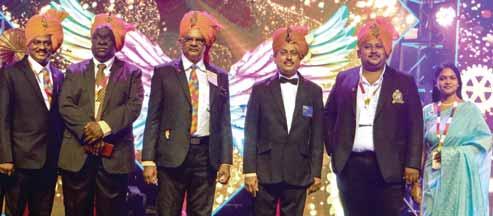
girl) one of the highest feats of my profession.”
Expressing his delight over a physical meeting after only online meetings and networking through social media, DG Nirmal Raghavan said, “my wife and daughter are excited to stay with over 200 Rotarians, Anns and Annets for three days in this beachside resort as fellowship is back again.” The district has added around 400 new members in the last two months (July-August), of which 200 have registered at the rotary.org portal. He urged club presidents to synchronise their uploaded projects and information with both rotary.org (My Rotary) and rotaryindia.org, besides making optimum use of the Rotary India App.
PDG Chandrabob said each club should sponsor at least one Rotaract club as “Rotaractors are given equal importance after their elevation in the hierarchy. With tremendous growth in the last two months, we can expect clubs to take up big service projects as opportunities open up.” In his address, district club service director and event chair M Rajanbabu exuded confidence that once again “we will see happy days”; District counsellor PDG Sampathkumar urged club presidents to do great service projects.
IPDRR Senthamarai passed the leadership collar to DRR Sujith Raju (21–22) as the new district Rotaract council took charge in the presence of Kotbagi. DG Raghavan told Rotary News that he had conducted Rotary Leadership Institutes for AGs, district secretaries, counsellors and trainers and a third one will be held shortly.
Picture by V Muthukumaran
Aziz Memon
440.9
Today, we all face continuing challenges caused by the pandemic. But when it comes to handling this pandemic, we are people of action: people who create lasting change. Equipped with the resources of the Foundation, we can make a difference in thousands of communities throughout the world. Our efforts include, but are not limited, to:
Ensuring the equitable distribution of vaccines
Combating vaccine misinformation
Slowing down the spread of the Covid virus.
So far, over $46 million have been used through global grants in the fight against Covid-19. We know that by June 30, 2021, our Foundation has raised and invested more than $5.5 billion for programmes that will have lasting effects in our communities. They will empower Rotary members to continue promoting peace, fighting disease, providing clean water, saving mothers and children, supporting education, and growing local economies all over the world.
Number of district grants: 467 Total funding: $31.1 million
Number of disaster response grants: 55 Total funding: $3.1 million
Number of global grants: 2,066 Total funding: $130 million
Number of programmes of scale grants: 1 Total funding: $2 million
This past Rotary year, we set an ambitious fundraising goal of $410 million. Rotarians rallied together and helped the Foundation surpass the goal and raise over $440.9 million. These funds have boosted our efforts to eradicate polio, empower peacebuilders from around the world and support memberled project implementation across our areas of focus through district and global grants. Thanks to the generosity of Rotarians and friends of our Foundation, we awarded more than $143 million towards global grants in 2020–21. Grants for polio eradication totalled $152.9 million.
The most important thing that Rotary members can do to continue the fight to end polio is to sustain our commitment towards polio eradication and this year, we are aiming high with the Building TRF Endowment: 2025 by 2025, initiative to build an endowment of $2.025 billion by the year 2025, while also supporting Covid-19 response activities.
I would like to emphasise on the need to enhance our engagement and leveraging of technology across Interact, Rotaract and Rotary club members and
other Rotary participants. We need to increase collaboration among all participants, particularly between Rotary clubs and Rotaract clubs. Our Rotaractors are growing up in the digital era, and we must utilise their talent in finding new ways to connect despite the constraint of social isolation. Now is the time to invite Rotaractors to shape our future.
I am sure that some of you have found creative and innovative ways to connect and serve, which we should maintain in the post-Covid era. Some clubs may adopt a new mix of online and in-person meetings, and of course one has the flexibility to do this if it works for their members.
At its best, Rotary provides a cradle for grassroots change. Whether it be PolioPlus, or global grants, it takes just an idea from one member to make a real difference. While thanking you for your outstanding service, I appeal to you to give what you can to The Rotary Foundation so that we can push forward the remarkable progress we have made for global public health.
The writer is a trustee of The Rotary Foundation

Parveen Jindal
Textiles, RC Moga Star, RID 3090
Whenhe was in Class 8, he was upset by the fact that his best friend could not attend school as his family couldn’t pay his fees. Having heard of Rotary and its “noble work, I ran to Rtn Nanda, then president of RC Moga, for help. His club paid the fees and sponsored the entire school education of my friend,” recalls Parveen Jindal on a watershed event of his life in 1986. Inspired by this gesture, he became an Interactor and then Rotaractor in 1990, led his district as DRR in 1996–97 and finally joined Rotary in 2000.
Five clubs in his district have achieved the ‘Each one bring one’ (EOBO) target, and one on its way to bringing two members each.
“I have plans to start 16 new Rotary, 32 new Rotaract and 64 new Interact clubs, besides 128 RCCs, during my tenure,” he says. He aims to add 1,000 new members to the existing 2,000-plus (July 1).
An MoU was signed with Tech Mahindra and Vaish Trust with the help of RILM to conduct adult literacy classes in Bhiwani district of Haryana. “We are reaching out to over 5,000 adult learners and also taking up relevant TEACH projects. Gradually, we will expand this dream project to select villages in our district,” he explains.
Project Prayaas Ek Muskan (attempt one smile) will fulfil the basic needs of children who have lost a parent to Covid by giving them cash assistance. “This project will provide students with stationery, healthy diet, medicines etc and help them complete their primary education.”
In a novel initiative, 16 school toppers from poor families will enjoy a flight, along with a 4-day stay, in a grand hotel under Sapne Such Hue (A dream come true) Project which, he hopes, “will boost our public image and earn goodwill.” This PR project will be done by November. His clubs will distribute 50,000 seeded pencils to students who, after using them, can just throw them and “they will blossom into trees in the next few years.” Jindal plans to create 50 Miyawaki forests in the urban clusters of Punjab, Haryana and Rajasthan. The clubs will also plant over one lakh saplings across the region. His TRF target is $150,000. His spouse, Rtn Nalini, got RI’s Best Spouse Award in 2014–15, and two children — son Rtn Mayank Jindal and daughter Ishika, a former district Interact representative — are quite active in numerous projects. Theirs is a PHF family.

Ashok K Mangal
Electrical engineer, RC Palanpur, RID 3054
Withfocus on environment, health and literacy, Ashok Mangal has instructed his clubs to take up tree plantations and health camps across Rajasthan and Gujarat, to improve Rotary’s PR in rural areas.
Over two lakh saplings will be planted by clubs and at least 50 PET bottle crushing units will be installed to clean up the plastic litter in residential zones. “We will hold more than 500 mega health camps in which the public will be sensitised through handbills, pamphlets and banners on the importance of leading a healthy life. Our members will reach out to the larger society through a sustained campaign on social media. At the medical camps, health parameters such as BP, obesity and diabetes will be tested and consultation given,” he adds.
Five global grant projects are in the pipeline including the distribution of medical equipment and oxygen concentrators (GG: $300,000) to 15–20 district hospitals. Under Literacy, “our clubs will take up projects across all the TEACH verticals reaching out to government schools.”
Mangal has set a target of $800,000 for TRF giving. He is confident of adding 1,000-plus members to the existing 7,000-plus, registering a 10 per cent growth in clubs. “I will be starting a number of satellite, passport, and cause-based clubs as hybridisation will be the norm in the coming years.” In the next 10 years, he says, “Rotary will be on top of the world as the no 1 NGO with Indian clubs leading from the front.” He joined Rotary in 1998 influenced by Rtn Nirmal Jain.
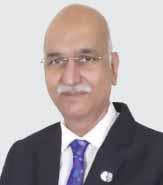
Hospitality, RC Nasik West, RID 3030
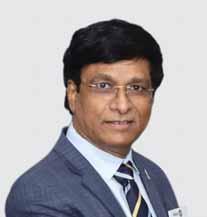
Company auditor, RC Hyderabad Central, RID 3150
Oneof his thrust areas will be shoring up Rotary’s public image by “involving a large number of non-Rotarians in service projects. Such a move will boost membership and help us to start new clubs in unrepresented areas in our region,” says Ramesh Meher.
A 5-day Rahat medical camp in Gondiya district, a Naxalite belt near Chandrapur, will be conducted. “Around 2,000 Rotarians will be taking up responsibilities in this medical project to be held in January or February, for screening over 25,000 villagers for general ailments and performing minor surgeries,” he explains. To mark the birthday of RI President Mehta on Oct 14, a four-day blood donation camps will be held across the district.
At least four dialysis centres (`30 lakh each) will be set up at government hospitals. Likewise, four neonatal ICUs (`50 lakh each) will come up at various hospitals. To empower girls, self-defence techniques will be taught to them in workshops. Five new clubs will be started in unrepresented areas such as Ozar, Niphad towns in Nashik district and remote areas in Jalgaon district. “I want to form at least 10 new clubs and add 750 new members to the existing 4,900 Rotarians.” Over 120 paediatric heart surgeries and 2,000 cataract operations are on the anvil through GGs and member contributions. His TRF target is $500,000. As Rotary meetings and fellowship events were regularly held at his popular hotel in Nashik, Rtn Jayant Sthalekar urged him to join Rotary and he became one in 1991.
Following the drastic cuts in governor’s expenditure and allowances by the RI board, “it has become tougher for us to visit rural areas to launch service projects and motivate people to join Rotary in far-flung remote areas of Telangana and Andhra Pradesh,” says K Prabhakar. Unless the DGs travel to villages frequently, service projects will be hit in these areas, he says. “I can only think of shifting the funds allotted for GML and other admin heads to our travel needs and related expenses which are critical for giving a push to impactful programmes in villages.”
His goal is an increase in membership by 1,500, and adding 30 new clubs, to take the total to over 5,400 and 114 respectively. A mammography van (GG: `1.5 crore) in Telangana and a mobile eye clinic (GG: `1.5 crore) in Guntur will be flagged-off shortly. Each project will reach out to 1,500 rural beneficiaries and the vehicles will be manned by skilled paramedical staff for proper diagnosis. “I will strive to induct at least 1,000 new Rotaractors across Telangana and two revenue districts of Andhra.” His target for TRF is $1 million.
But his biggest worry is the pandemic badly affecting Rotary projects in villages and “we have to resume our work there to sustain our public image in far-flung areas.” Another challenge, he says, is some Rotarians find the annual dues high and “it will be tough to retain the existing members.” To induct new Rotarians, “I have to travel regularly, but with limited funds to accomplish this task.” In July alone, he attended 30 club installations. “They seek my presence to induct new members to boost their morale.” He joined Rotary in 1995 inspired by Rtn Vijayalakshmi Shekawat.
Designed by N Krishnamurthy
School education is under transition, with the pandemic forcing students and teachers to use smartphones for online classes. “Now classes are being conducted on smartphones, whereas in the recent past we had discouraged students from using mobile phones,” said RID Mahesh Kotbagi. Teachers have a great responsibility as they “have to update their skills, use technology to upgrade or else become outdated,” he said.
Addressing a webinar titled Teaching in the 21st century hosted by RC Solapur, RID 3132, Kotbagi said in the near future students will not be
carrying heavy school bags, for just a computer tablet will do, thanks to the digital makeover of classrooms.
RILM chair Kamal Sanghvi said Covid has speeded up Rotary’s literacy mission. “We have successfully taken our digital learning content to 15 million households through Doordarshan’s Free Dish, 420 million users through Jio Mobile, 70.26 million households through Tata Sky and also initiated a million learning sessions through the Diksha portal.” The Sikkim and Haryana governments have approached RILM to upload the e-learning software for their government schools and many
other states have followed suit, he said. Thanking teachers for “all that you do for our children who are our most sustainable assets,” Sanghvi said, “you should excite your students to teach (illiterate) adults to read and write. This will make India a 100-per-centliterate country.”
In a presentation, Ranjitsinh Disale, winner of the Global Teacher Prize 2020, said the 21st century students are being taught by teachers who are still living in their 20th century mindset of physical classrooms. “Technology
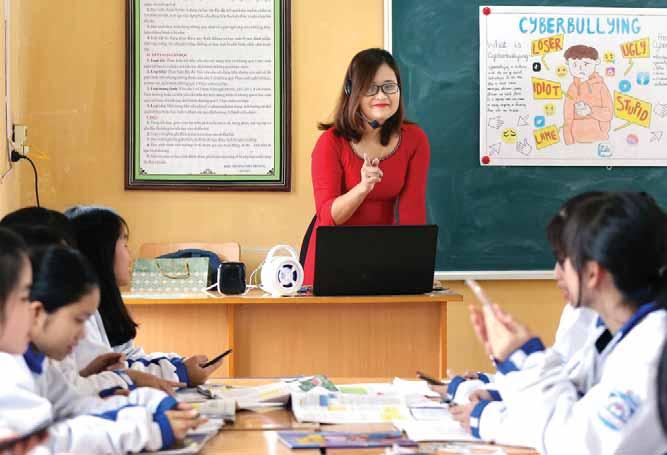
cannot replace a teacher but she must upgrade and develop her skills to suit the needs of digital-savvy students,” he stressed. Covid has changed the fundamental concept of classroom forever and teachers across the world are facing problems teaching online “because we are not ready for this change and not trained for online teaching,” said Disale. For teachers, learning is a continuous process, but they must understand that “children learn at their own pace and require curated content to personalise their learning experience if we want to succeed.” With the help of technology, he had designed QR-coded lessons based on the learning abilities of the students in his classroom. Over 3,500 teachers from around the world took part in the virtual deliberations and brainstorming on the new and emerging teaching methods vis-a-vis digital education.
Sharing her vision of ‘borderless classrooms’, Ha Anh Phuong, an

English teacher from Vietnam and one of the finalists of Global Teacher Prize 2020, said “Students, teachers and experts no longer need to be in the same place for the learning process now. Using video and collaboration software, we can create borderless classrooms that are open to any child in the world.” Digital
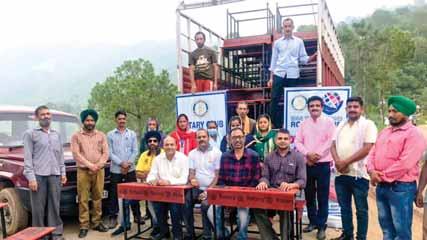
technology, she added, “bridges the gap between students living in cities and those in the villages.”
PDG Zubin Amaria, RID 3132, thanked the speakers for their valuable inputs and encouraged them to “apply the knowledge that you have gained in this virtual event in your own classrooms.”
Classrooms should attract children with good seating facilties and comfortable benches. Only then they will be inspired to learn,” says DG Ajay Madan, RID 3080. When he assumed charge of the district in July he drew up plans to provide 10,000 benches and desks to government schools through various Rotary clubs in the district. Until August, the district has despatched 2,200 sets of furniture, embossed with the Rotary logo, to benefit 55 schools. The total project cost is ` 1.5 crore. “Each of these sets can seat two children and assuming that they will last for at least seven years, I am glad to say that this project will benefit 140,000 children over the years,” says the DG.
Vanessa Glavinskas
Long before he became Rotary International’s president, Shekhar Mehta was known for setting ambitious goals.
His reputation for successfully tackling difficult problems is why, in 2014, former RI president Kalyan Banerjee asked him to lead an effort to make India fully literate — a goal that has eluded the Indian government as well as many NGOs.
“I realised making a country literate is no easy task,” says Mehta, who defines full literacy as an overall rate of 95 per cent or above for those aged 7 and up. (The government of India estimates India’s current literacy rate among that group at 78 per cent.) “But I strongly believe in Gandhi’s view that if you find the goal, the means will follow.”
An accountant and real estate developer, Mehta didn’t enter the endeavour with any experience in education. “I had no clue, no background in education
at all,” he says. He spent about nine months learning from experts before founding the Rotary India Literacy Mission (RILM), a nonprofit that aims to strengthen and standardise Rotary clubs’ literacy initiatives across India.
To accomplish this, RILM created a programme of service projects that it encourages clubs across India to take on with the nonprofit’s support and mentorship. The projects are built around the acronym TEACH, which stands for teacher support, e-learning, adult literacy, child
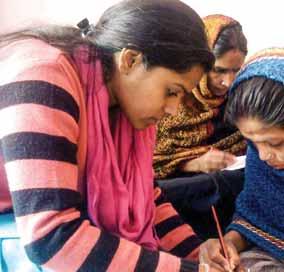


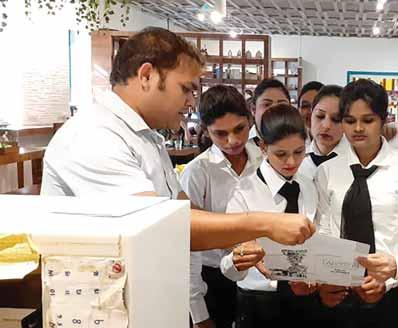
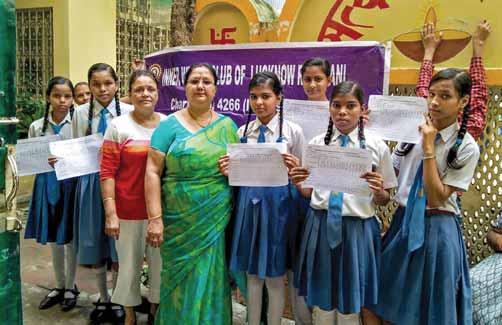


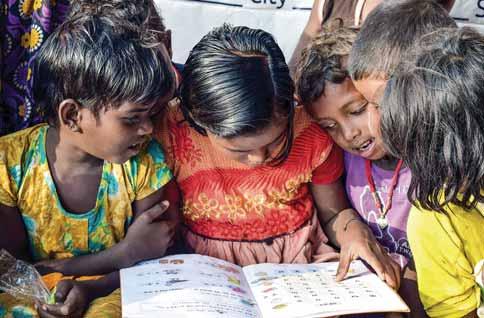
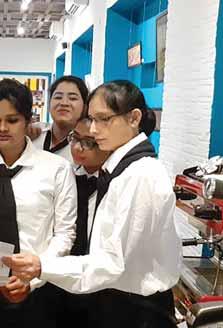
development, and happy schools (which focuses on infrastructure improvements). “We think every school should be a school where our own children would be happy to study,” says Kamal Sanghvi, who was an RI director from 2019 to 2021 and chairs RILM now that Mehta is RI president.
Following the model that made India’s polio eradication campaign a success, coordinators promoted the TEACH
programme in Rotary zones and districts in the country. RILM staff created manuals and organised trainings, and now nearly every club in India works on a project to support at least one aspect of the TEACH programme. “The momentum picked up so beautifully,” Sanghvi says. “Rotarians understand that for any nation to achieve greatness, you need a high literacy level.”
The combined efforts of hundreds of Rotary
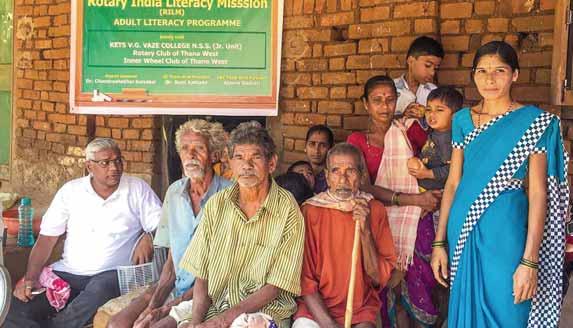
clubs, plus their partner organisations, have added up to large-scale results. To date, an estimated seven million children are benefiting from RILM’s teacher training component alone. The programme’s overall reach is enormous.
“Training, standardisation, and developing partnerships — these are the three things that make the programme work,” Mehta says.
Due to its impact, Rotary India Literacy Mission gained name recognition, which recently led to its largest initiative yet — working with the Indian government to create and distribute free e-learning content to children who were out of school because of the Covid-19 pandemic.
“In a lot of areas in India, internet penetration is very poor,” explains Biswajit Ghosh, RILM’s chief operating and strategy officer. “And the government was struggling to provide online education for the masses.” That’s when Ghosh says Rotary “put up its hand” and offered to facilitate the creation of high-quality multimedia content for grades 1–12.
RILM worked with a video production company to create the content, covering the cost through donations and sponsorships so that e-learning would be free to the nation.
The E9 is a group of nine countries — Bangladesh, Brazil, China, Egypt, India, Indonesia, Mexico, Nigeria, and Pakistan — that represent more than half of the world’s population and large education systems, and 70 per cent of the world’s illiterate adults. Their collective efforts considerably influence the success of global education initiatives.
The following countries have adult literacy rates below 50 per cent:
Afghanistan
Benin
Burkina Faso
Central African
Republic
Chad
Côte d’Ivoire
Guinea
Guinea-Bissau
Liberia
Mali
Niger
Sierra Leone
Somalia
South Sudan
In 2020, India’s government began broadcasting the Rotarysponsored content on several TV channels — one per grade — in both English and Hindi. The lessons were available to about 100 million students across India, Ghosh estimates.
The goal now is to get the same multimedia curriculum translated into more of India’s languages and to provide the software to every public school in India. “The level of education in the villages is far lower than in the cities,” explains Sanghvi. “In the city, they simply have better access to technology and knowledge.”
But while a large-scale rollout of e-learning could help lessen this disparity, it will only work if teachers know how to use the software. That’s where the “T” in TEACH comes in. “We’re training teachers across India,” Sanghvi says, adding that the urgency to do so became apparent as soon as India went into its pandemic lockdown. “Many teachers didn’t know how to start a Zoom,” Sanghvi says.
The nonprofit works with partner organisations to provide the e-learning training and also offers an award to teachers who excel — as judged by their students and the school principal. It works like this: Rotary clubs survey local students, and that feedback is the basis on which a teacher is selected to win a Nation Builder Award. Teachers who score poorly are targeted for future club-sponsored training programmes. “We learn which teachers are outstanding and who needs to get their skills upgraded,” Sanghvi says. “It’s a win-win for us.”
Despite RILM’s success in improving literacy among children, India will not be able to achieve total literacy without addressing its
Rotarians understand that for any nation to achieve greatness, you need a high literacy level.
estimated 287 million illiterate adults, who make up about one-third of the world’s illiterate-adult population.
Sanghvi says that illiterate adults have not been served well by government efforts to increase India’s literacy rate. So RILM facilitated the publication of a small workbook and primer that will help adults take the first step toward “functional literacy” — being able to read street signs and write their name, among other basic skills.
Local clubs distributed this primer to students, and asked that “each one, teach one” — in other words, a child with a family member who cannot read or write could use this primer as a tool to teach them the basics. “The schoolchildren were excited,” Sanghvi says. “They’d say, ‘Oh gosh, I’m going to become a teacher!’”
RILM’s goal is to make every Indian citizen at least functionally literate — able to engage in the everyday activities in their community that require basic literacy. The pandemic forced RILM to extend its deadline by two years. The group now hopes to achieve this goal by 2027.
It’s an ambitious goal, Mehta concedes, but “Rotary is thriving in India,” he says. “So, we need to dream.”
© Rotary
Following extremely heavy rains in Mahad, an industrial town in Raigad district of Maharashtra, and based on feedback received from local Rotary clubs, a detailed study was done jointly by RCs Deonar, RID 3141, and Mahad, RID 3131, to understand the extent of flood devastation and what ways Rotary could provide relief to the affected families.
In Taliware village, people were sitting on the terrace due to flooding of their houses. Water creatures including crocodiles were spotted at residential zones, even as roads and houses were washed away by the torrid currents. The affluent families in Mahad too had to vacate their posh houses and retreat to safe places. Past president Rajendra Datye from RC Deonar worked out the entire plan with club president Sudhir Mehta. The total requirements received from ground zero were lesser than the donation they already had in place for this project. PP Dhananjay Ajagekar from RC Mahad drew up an assessment of flood situation in Mahad and its surrounding areas.
It was learnt that there was no shortage of food and water. But there was acute need of other supplies like bedsheets, blankets, plastic chatais (mat), towels, pillows, tarpaulins etc.
The flood-relief team swung into action and procured the essentials that were sought after by the flood victims. For this, the team had to identify the right vendors to ensure the quality of products that were being sent to Mahad. In the first phase, Rotary clubs reached out to 200-plus families, mainly living on the outskirts of Mahad and a few pockets in the main town. During the second phase, 500 ration kits were sent to Mahad. Rtn Ajagekar visited gram panchayats to finalise the exact number of ration kits needed in these areas in
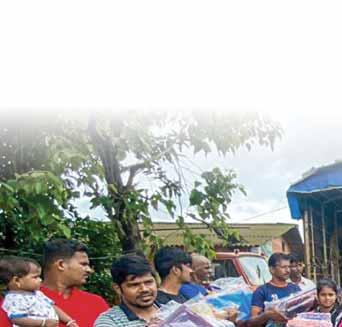
and around Mahad. Two teams took up the distribution of food items over four days at the flood-hit areas.
RC Chembur came forward to support the flood-relief work of RC Deonar. Rotaractors too joined the team from RC Deonar who travelled to Mahad to distribute the relief material including grocery kits with the help of RC Mahad.
“It was a most satisfying and fulfilling exercise for us. We were delighted to connect with Rotarians in and around Mahad,” said Rtn Vishnu Kamat from RC Deonar. Sharing his experience, project chair Datye said, “Living in Mumbai, we had the power to extend our helping hand 250 km away in an area that was in dire need of this assistance. This is the power of Rotary.”
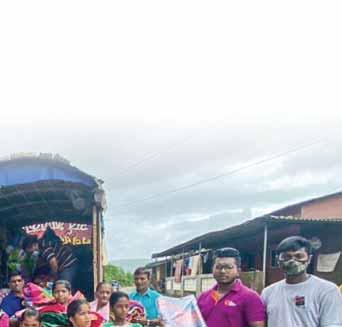
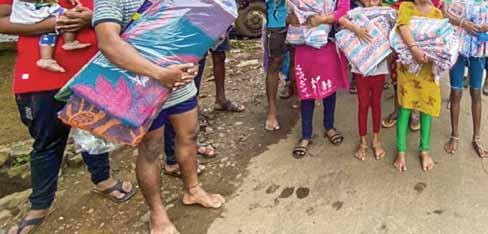
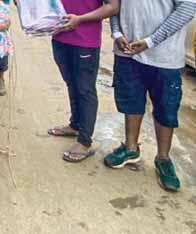

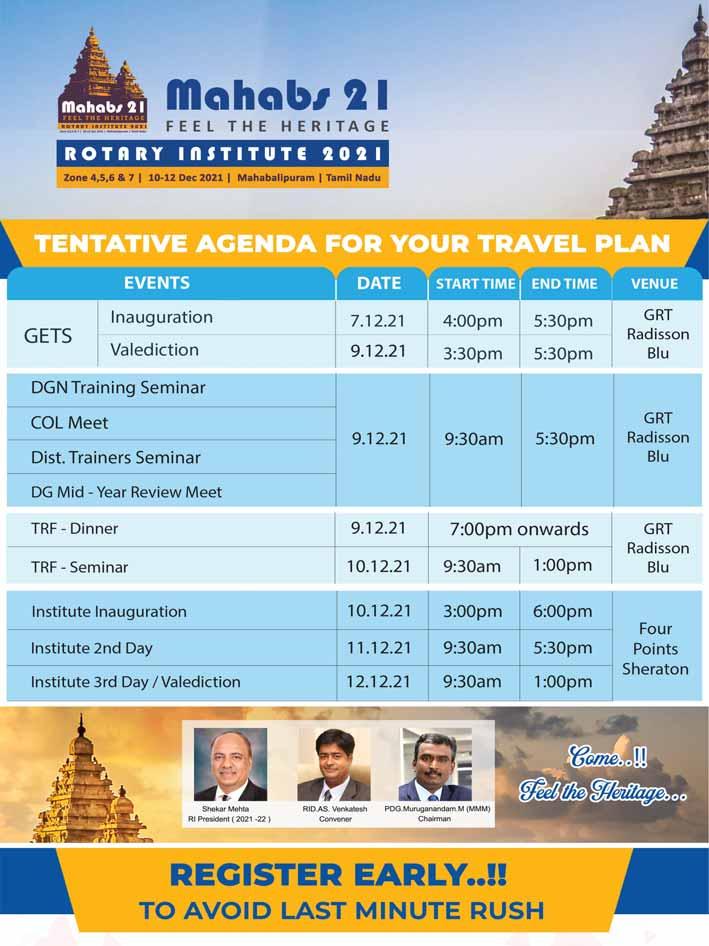
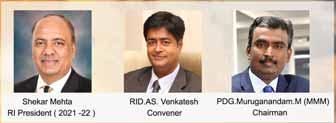

Around 100 multispecialty health camps were held across RID 3012 with all the 126 clubs taking part in a mega Rotary Day programme (Aug 29) that reached out to over 50,000 beneficiaries. In these medical camps, various tests, eye and retinal screening, dental check-up, mammography and cancer screening, ECG and bone mineral density tests were done free of cost for patients.
In a curtain raiser to Rotary Day events, DG Ashok Aggarwal had informed the media earlier that all the clubs from across the district will hold medical camps, blood donation camps, Covid vaccination awareness rallies and other service projects at various locations. The clubs had put up 150 hoardings, and ran campaigns on radio and other print media to spread awareness about the health camps and a cycle rally on Covid vaccination in Ghaziabad.
Announcements of various Rotary programmes were made on local TV channels.
To mark Rotary Day, RID 3012 adopted 1,000 children suffering from tuberculosis and their entire treatment will be sponsored by the clubs. They will also be given nutritional food for a healthy life. An ambulance was donated to the Charak Ayurvedic Medical College Hospital and Research Centre at Panchi
village near Meerut, UP. “Our Rotary Day projects were a massive public image exercise that impacted over one crore people on a single day,” said DG Aggarwal.
On the vaccination front, he said the district clubs had inoculated over 100,000 people with the support of health department and private hospitals and the figure is raising each day.
Health cards to poor Rotary Ayushman Health Cards (RAHC) were given
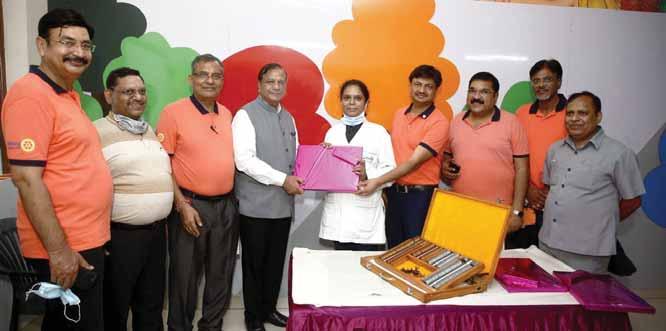
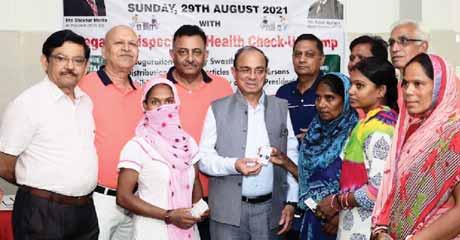
PDG JK Gaur (centre) distributing health cards introduced by RC Sonipat Midtown for underprivileged women.
by RC Sonipat Midtown, RID 3012, as part of Rotary Day events, to
underprivileged families who could not afford proper medical care.
The club has empanelled 19 hospitals in Sonepat which will
provide OPD and consultations at `50 per head, while all lab and diagnostic tests will be done at 50 per cent discount for the RAHC beneficiaries. “We plan to give these health cards to 1,000 families which will help about 4,000–5,000 people,” said Rakesh Devgun, club president. The project was inaugurated by PDG JK Gaur who distributed around 300 cards on the occasion. PP Sandeep Jaitley chaired the meeting.
All the seven clubs in Pokhara, Nepal, came together to form a Covid task force after the second wave hit the Gandaki province and its neighbouring areas leading to a surge in casualties. “Many people lost lives due to shortage of medical oxygen and beds at the hospitals,” said PDG Kiran Lal Shrestha, RID 3292.
Project Jeevan ko Aasha was launched by the Pokhara clubs with an aim to start an oxygen cylinder bank. Rotarians collected cylinders from workshops and factories that were shut down during the lockdown with an assurance that they will be returned later.
In all, 350 oxygen cylinders, 125 concentrators and other medical accessories were distributed to various hospitals in Pokhara and other rural outpost with support from international partners such as RIDs 3523, 6250, 7080, Nepal China Friendship Association, Inner Wheel clubs,
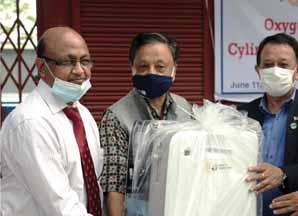

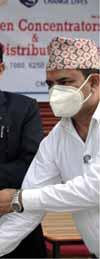
From L: Dilip Agrawal, dean, Manipal Medical College Pokhara; PDG Kiran Lal Shrestha; Man Bahadur GC, Mayor of Pokhara and club president Jitendra Sigdel, with an oxygen concentrator.
Rotary from Taiwan and Cao Zhong Zhi Foundation. RC WoodstockOxford, Canada, RID 7080, and RID 6250, Hawaii, US, supported the project, while RID 2540, Japan, helped in providing 200,000 masks.
“The cylinders, concentrators and other stocks were distributed
through Rotary clubs and Rotarians to hospitals in and around Pokhara,” said Shrestha who coordinated with the clubs and took care of the logistics. A Rotary Manipal Covid Centre was also set up in partnership with the Manipal Teaching Hospital, Pokhara.

Preeti Mehra
Automation can bring home many benefits and a new lifestyle.
Innovation has become the heart of the green energy movement. It has brought with it options that sometimes go beyond imagination. But which promise an easier and more secure life for those ready to embrace technology. For senior citizens or those with disabilities, technology can sometimes be a boon. Stephen Hawking, for
instance, could not have achieved what he did if he had not befriended tech options to get ‘mind over body’. For busy home makers and office goers too, there is nothing like a little help from high-tech.
Yes, we are talking about the concept of ‘smart homes’ that helps you do a plethora of jobs at the same time. Apart from installing solar or



wind energy and water harvesting, introducing automation at home is a good option. It gives you the ability to control climate, security, lights, and entertainment on a single device. With children and senior citizens at home, these are often combined with a surveillance device that informs you about the safety and security of your loved ones when you are away.


All this can be achieved by putting in place an automation system. There are several players in the market who provide the devices. If you only want to use smart technology for your lights or for your geyser, that too is possible. A good technician could fit it for you. You don’t need to redo the house to introduce smart features in it. However, there are also technology companies now dealing exclusively in setting up smart homes for customers. They offer automation by using the Internet of Things (IoT) technology. But more about this later…
Apart from convenience, a big bonus from home automation is a decrease in the consumption of energy and hence lower electricity bills as well! And a bigger bonus is that it reduces your carbon footprint, helping


you to participate in greening the world and mitigating climate change.
The advantages of home automation systems are many. On the energy front, first and foremost, you can regulate the lights and fans in your home. The system turns them on and off as and when family members enter and leave a room, making sure that electricity is not being wasted on an empty room. Room temperature too can be controlled with air conditioning and heating decreasing automatically if you are away.
The temperature changes can also be coordinated with other automated electronics such as the window shades, lamps, lights and fans. In fact, automated motorised window shades are very useful and just need the touch of a button to open and close. They can also be programmed to operate at peak efficiency by closing and opening automatically at specific times of the day.
Automation also gives you the luxury of an ‘All Off’ command. So, in case you have to leave home in a hurry during an emergency or are going on holiday, the system gives you the option of shutting down the entire home or modifying specific electronic devices with the click of the finger. It can also arm the home security system, so that you have nothing to worry about while you are out.
It is well known that appliances such as a toasters, microwaves, dryers and chargers when left on the plug drain out some amount of power even when they are in ‘off’ mode. According to some estimates, these can even represent five to ten per cent of your electricity bill. Home automation allows you to undo the appliance standby modes without you having to unplug each of them, and in turn helps lower your energy charges.
The most popular today are automation systems based on IoT. If you Google for smart home solutions several options come up and a choice could
You don’t need to redo the house to introduce smart features in it. Some technology companies now deal exclusively in setting up smart homes for customers.
be made according to the city you live in. I checked out Smartify first, which offers an IoT based system. The company claims that this provides a lot of flexibility over wired systems and that there is ease of use and no wires running around or loose electrical connections. Next, I checked out Smartnerd, which also offers multiple solutions and a curated list of smart devices.
IoT systems consist of remote servers that are located on the internet and can be configured to control and monitor multiple sensors that would be installed wherever necessary in the home. This main controller or gateway as it is called, is connected to the home router through an ethernet cable. The sensors receive commands through the gateway and perform the action that they have been automated to do. Smartify offers various packages at different price points — basic, advanced and premium — depending on the tasks that need to be automated.
Most green buildings today have these smart features embedded along with the construction itself, and often contribute to redefining how people live. But even in standalone houses or old flats, it is not exorbitant in the long run to transform your home into a ‘smart home’, enhancing your comfort zone.
The writer is a senior journalist who writes on environmental issues.
Designed by N Krishnamurthy

















For Hindustani music








lovers with Hyderabad connections, the sixties and seventies of the last century were a golden era of sorts, with high quality concerts on offer at the Health League grounds and other open-air venues in the twin cities, as well as the modern Ravindra Bharati auditorium. And if you happened to be friends with local musicians, you enjoyed the bonus of attending chamber concerts and weekly Guruvar recitals in the humble homes of musicians paying homage to the gurus they venerated.
You could then run into local musicians of the calibre of Malini Rajurkar or Bhimshankar Rao there.
Pandit Motiram Punyatithi concerts, which later evolved into the Pt Motiram-Pt Maniram Samaroh, a yearly tribute to the memory of both Jasraj’s father and his brother-guru.
In the 1970s, we were treated to the brothers Maniram and Jasraj singing together, sometimes accompanied by the middle brother Pratap Narayan. The Hyderabad audience was a knowledgeable one, capable of appreciating what each of the three brothers brought to the table, but was keenly
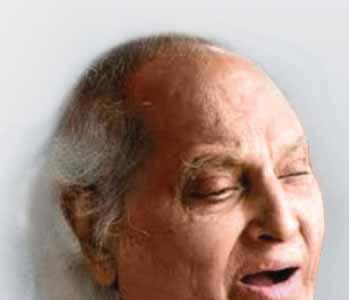

A young duo, Girish Wazalwar and Chandrasekhar Swami, sometimes made surprise appearances at the Guruvar soiree — though not really a surprise, as they usually accompanied their guru Pandit Jasraj, performing at the annual
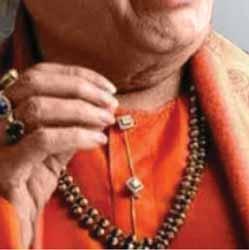

aware that it was in the presence of a very special talent in the youngest of them. The amazing range of his strong, malleable voice spanning three octaves, the depth of his raga explorations, his control over rhythm and his dramatic body language that combined surrender to the music and showmanship in almost equal measure revealed a megastar in the making. The enchanted listeners knew that they were privileged to witness a new sensation on the horizon. His renditions of ragas like Jog, Adana (featuring the famous Mata Kalika) and Bhairavi were trance-inducing, and you went home in a daze, the music echoing in your heart and mind for days after.
The purists initially critiqued his borrowing of elements from other gharanas or schools of Hindustani music, his flair for

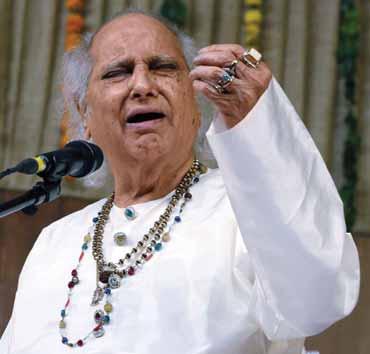
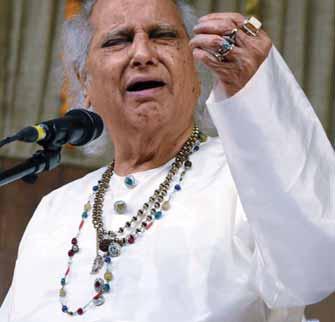
thumri, his involvement in the semi-classical haveli music, his increasing injection of the devotional quotient into what was essentially art music, his Jasrangi male-female jugalbandi Eventually, his charisma and masterly communication with the vast majority of listeners led to Jasraj becoming arguably the best known vocalist of his genre after Amir Khan and Bhimsen Joshi.
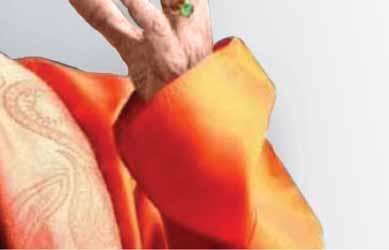
All that was in the future, but that decade or so, when many of us discovered a maestro in the making, was, in my view, the apogee of his music, pure and uncluttered by considerations other than sheer musicality. The magic of that phase was perhaps rarely captured in the decades that followed, though

he did cast a spell every now and then, inspired by his muse of the moment.
One memorable concert in the 1980s took place at the Kalakshetra auditorium, where, the presence of Rukmini Devi Arundale in the front row, was the impetus he needed to reach







Suffering from a rasping cough and sore throat at the start of a concert, Jasraj opened with an apology to the audience and a request to be allowed some leeway while getting warmed up. Fifteen minutes was all it took for him to emerge out of that depressing start.


















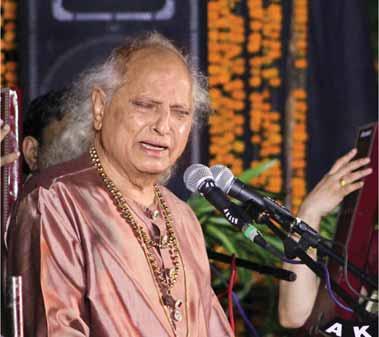
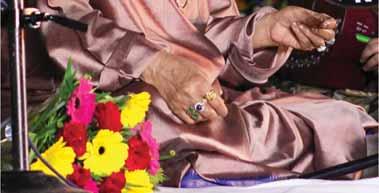
deep within himself to produce some otherworldly musicianship. Jasraj had been known as a boy to care deeply for his mother whose tired feet he would press at the end of a long day with a devotion unusual in one so young. In Rukmini Devi, he self-confessedly saw his own late mother. This yearning for that umbilical link seemed to be a recurring motif in his life, perhaps deeply reflected in his emotion-packed rendering of Mata kalika
Another Chennai concert, in the new millennium, at Sri
Krishna Gana Sabha, was to reveal the steely resolve of the stalwart musician he was, and the triumph of decades of discipline and hard work over fatigue and illness. It was being whispered that Panditji was past his best, that his voice had lost its malleability; and he had a rasping cough and a rock-hard sore throat at the start of the concert. He could barely speak as he opened with an apology to the audience and a request to be allowed some leeway while getting warmed up. Fifteen minutes was all it took for vintage Jasraj to emerge out
of that depressing start. It was unbelievable, but aren’t great artists known to perform such miracles? Something similar had happened to MS Subbulakshmi at a UN concert years earlier, and like MS then, Jasraj attributed the miracle to a higher power.
Born in Pili Mandori, a village in what is now the Fatehabad district of Haryana, Jasraj spent his childhood years in the Nizam’s state of Hyderabad, where his father Motiram Pandit was a Hindustani classical vocalist, on the verge of joining Nawab Mir Osman Ali Khan as his court musician, when he passed away in 1934. Jasraj was just four. Motiram Pandit had earlier been a musician in the court of Raja Pratap Singh of Kashmir.
From Hyderabad, Jasraj often travelled to Sanand in Gujarat to study music in the Mewati gharana to supplement his lessons from eldest brother Maniram. He also learnt to play the tabla from brother Pratap Narayan. In 1946, he moved to Calcutta, where he began his music career as a tabla
His renditions of ragas like Jog, Adana (featuring the famous Mata Kalika) and Bhairavi were tranceinducing, and you went home in a daze, the music echoing in your heart and mind for days after.
accompanist to his vocalist brother-guru Maniram. Friends who felt he was wasting his vocal talent persuaded Jasraj to discard the tabla and focus on becoming a concert vocalist. Like many great names in Indian music, Jasraj started his singing career with All India Radio. His stage debut came as late as 1952 when he sang at the royal court in Kathmandu. Gradually, his career started to flourish and he never looked back. In addition to Maniram, he also benefited from the tutelage of Jaiwant Singh Waghela and Gulam Qadir Khan of the Mewati gharana, as well as Swami Vallabhdas Damulji of the Agra gharana. In 1962, he married Madhura, daughter
Bhimsen Joshi was once said to have acknowledged to young Jasraj how close he was to reaching the senior’s level of accomplishment; and that was high praise indeed.
of film director V Shantaram, moving to Bombay soon afterwards. Followed the most productive years of his life as a musician.
In a career spanning 75 years, Jasraj constantly expanded

his repertoire, inspired young musicians, collaborated with a variety of musicians across India, mentored many disciples, taught and performed tirelessly across the globe, and became a towering, revered figure in his field. The bhakti element became a prominent part of his music making, with slokas and devotional verses dominating the content of his offerings on stage and his recordings. Yet there was, in his music during his forties and fifties, something even more deeply spiritual than in all the devotional compositions that earned him countless followers in the years that followed. As editor of Sruti magazine, I came to see a little known
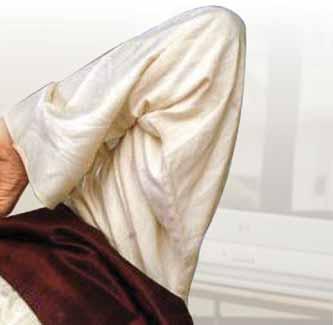

























side of Jasraj when I had the pleasure of publishing an article of personal reminiscences by T S Ananthu, a Tamil, who grew up in Calcutta. His brother and sisters learnt music from young Jasraj, then living there with Pandit Maniram. Often visiting his pupils’ home after strenuous late-night riyaz, Jasraj would drop off to sleep while the sishyas were practising. The girls put up a sign on the divan that said: “Sofa par sona mana hai.” Jasraj coolly ignored the sign and went to sleep on the sofa anyway, and burst into song with those very words when woken up!
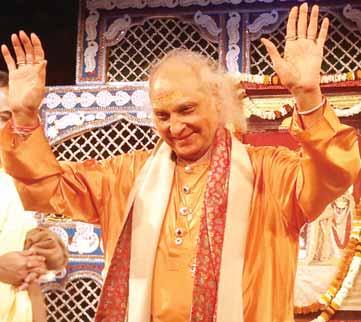
Jasraj had been known as a boy to care deeply for his mother and in Rukmini Devi Arundale, he self-confessedly saw his own late mother.
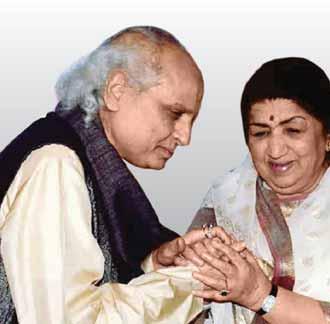


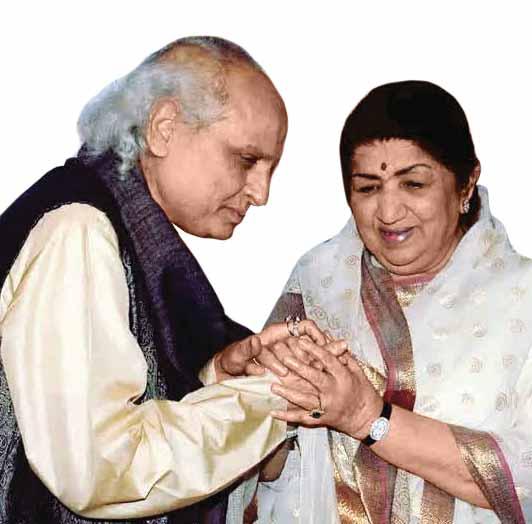
On a visit to Mumbai many years later, Ananthu’s mother tried to contact Jasraj but left only her name, not her phone number after failing to reach him. The year was 1988, and Jasraj was already a star with a huge fan following, but moved heaven and earth to trace her local address and visit his old Calcutta friend “Mrs Subramaniam”. Bhimsen Joshi was once said to have acknowledged to young Jasraj how close he was to reaching the senior’s level of accomplishment; and that was high praise indeed. All his life, Jasraj strove for that level of achievement and acceptance. With the title of Sangit Martand, the award of Padma Vibhushan and the several other honours conferred on him, his cult figure status, and a loving family and adoring disciples, the veteran indeed walked tall.
The writer is an author and former editor of Sruti magazine
Designed by Krishnapratheesh S
Kiran Zehra
Rotary Club of Surat, RID 3060, under its women’s empowerment programme, has started a vocational training centre in Amroli, Surat, to train women in tailoring. The centre, sponsored by club member Babubhai Jariwala,was recently inaugurated by IPDG Prashant Jani in the presence of DG Santosh Pradhan and DGE Shrikant Indani.
Ajay Mahajan, a past president of the club says, “the pandemic has led to many people losing their jobs and families struggling to have a single decent meal. Women are harrassed and domestic violence has increased in Surat. We wanted to help these women learn a new skill and financially support their families.”
It is a certificate programme of two-month duration and the centre helps women set up their own tailoring unit and provides space and sewing machines to those who do not have one.
Mahajan says that the centre will also help in “developing their capacities in leadership, skill development, finance management and entrepreneurship.”

The first day of class, for Meghna (35) from Amroli was “like a rebirth. I met many women who were struggling just like me but it was very encouraging to see them step forward to earn a decent living. I have made a lot of friends here.” Her husband was the only earning member in the family and after he lost his job during
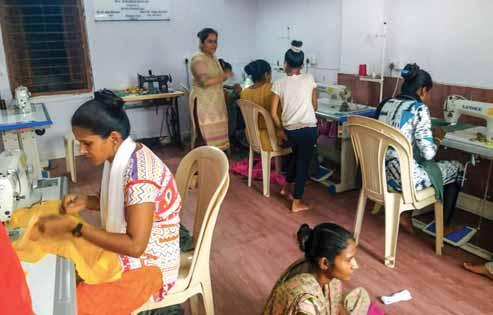
Young women learn tailoring at the centre.
the pandemic “I had to fill his shoes by taking up odd jobs. But now I don’t have to go door-to-door and clean utensils,” she adds. She earns `200 per kurta but more than the money, “I have the satisfaction of creating something and I can take care of my family better and focus on my children’s well-being. My husband is proud of me,” she smiles.
“When Meghna stitched her first kurta and received payment, we felt very happy as she said it went to pay her child’s school fees,” says Mahajan. Currently, the centre is equipped with seven sewing machines and trains 25 women. “We will be adding few more machines soon and will gradually expand our activities to train women in beauty care, agarbatti-making and handicrafts,” he adds.
The centre is run and managed by the club’s RCC.
Having 296 clubs across 109 Rotary districts in 33 countries Rotakids “is a fun and exciting way for children aged 7–12 to make friends and get involved in important activities in the community while having a great time in the process,” said DG Ramesh Meher, RID 3030. Congratulating RC Chopda for installing the first Rotakids club — Rotakids of Chopda he said, “with the help and support from teachers, Interactors and Rotaractors and your club members, these children can gain valuable experience in helping others and learning interesting new things.”
Nine-year-old Aarav Gujarathi, the charter president of the Rotakids of Chopda accepted the charter certificate in the presence of secretary
Houston Convention
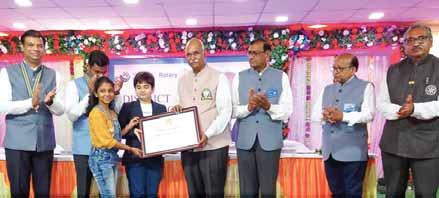
Purvi Jain, treasurer Manan Gujarath. RC Chopda president Pankaj Borole welcomed the children to “our Rotary community where you will help us make this world a better place.” He also explained that Rotakids aims to
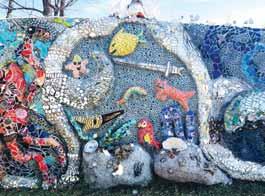
One of the delightful aspects of Houston is its eye-catching public art, which expresses the city’s lively and diverse culture. While you’re at the 2022 Rotary International Convention, June 4–8, make sure to take in some of the incredible murals and mosaics on display around the city.
help the youngsters understand the importance of community service through a fun way.
Former Maharashtra Legislative Assembly speaker Arunbhai Gujarathi was also present at the event.
If you are near the hip EaDo (short for East Downtown) neighbourhood, check out the “Abstract Happy Beach Wall” at 801 Chartres St. The vibrant colours of the mural, painted by Barcelona-based artists Zosen and Mina, can make any day feel sunny. Or take a stroll around Market Square Park in the nearby Historic District and see the “Houston Is Inspired” mural, a design so full of life that it will give you enough energy to explore the entire city.
At Smither Park, a public park dedicated to sustainability, you can view beautiful creations made with bottle caps, broken ceramic tiles, seashells, and other found items. One element is known as the “Memory Wall”: With 60 panels by artists from all over the world, it serves as a tribute to lost loved ones and memories past. The park is also home to the Lindley Fish Amphitheater, a performance space created by artist Matt Gifford, and it is in the form of giant fish mouth.
End your visit to Smither Park in the Marilyn Oshman Meditation Garden, an all-white installation that compels you to focus on the fine mosaic details. Recycling pieces from domestic spaces like the kitchen and dining room, this garden proves that there’s no place like home — except Houston.
Learn more and register at convention.rotary.org.
Rotary Grant Staff contact details: For global grant application and reporting, contact the staff person for the district where the grant activity will take place or, in the case of global grant scholarships, where the scholar candidate originates from.
2981, 2982, 3000, 3011, 3012, 3090, 3100, 3271, 3272
3110, 3120, 3201, 3203, 3204, 3211, 3212, 3220, 3231, 3232, 3291
Sadaf Ajani sadaf.ajani@rotary.org, 847-866-3114
Jennifer Berg jennifer.berg@rotary.org, 847-425-5660
Global Grant
Application
District Grant
Reporting
3020, 3141, 3142, 3150, 3160, 3181, 3182, 3190, 3292
Laura Bradley laura.bradley@rotary.org, 847-866-4457 3281, 3282Cathleen Evans cathleen.evens@rotary.org, 847-866-3308
3030, 3040, 3053, 3054, 3060, 3070, 3080, 3131, 3132, 3170, 3240, 3250, 3261, 3262
3000, 3012, 3054, 3132, 3141, 3160, 3182, 3190, 3212, 3231, 3240, 3261, 3291
3011, 3020, 3053, 3060, 3131, 3142, 3150, 3170, 3181, 3201, 3232, 3250, 3262
2981, 3030, 3070, 3090, 3100, 3110, 3120, 3203, 3204
Chandra Palmer chandra.palmer@rotary.org, 847-866-3183
Sumit William sumit.william@rotary.org, 011-42250150
Nelson Abraham nelsona.braham@rotary.org, 011-42250116
Sumit Sharma sumit.sharma@rotary.org, 011-42240151
2982, 3040, 3080, 3211Roy John roy.john@rotary.org, 011-42250146
3271, 3272
3220
Sadaf Ajani, sadaf.ajani@rotary.org, 847-866-3114
Jennifer Berg, jennifer.berg@rotary.org, 847-425-5660
3292Laura Bradley, laura.bradley@rotary.org, 847-866-4457 3281, 3282Cathleen Evans cathleen.evans@rotary.org, 847-866-3308
ApplicationsAll districts Roy John, roy.john@rotary.org, 011-42250146
3000, 3012, 3054, 3132, 3141, 3160, 3182, 3190, 3212, 3231, 3240, 3261, 3291
Reporting
3011, 3020, 3053, 3060, 3131, 3142, 3150, 3170, 3181, 3201, 3232, 3250, 3262
2981, 3030, 3070, 3090, 3100, 3110, 3120, 3203, 3204
2982, 3040, 3080, 3211, 3220, 3271, 3272, 3281, 3292
Sumit William sumit.william@rotary.org, 011-42250150
Nelson Abraham nelsona.braham@rotary.org, 011-42250116
Sumit Sharma sumit.sharma@rotary.org, 011-42240151
Roy John roy.john@rotary.org, 011-42250146
For questions about disaster response grants, write to grants@rotary.org, and for programs of scale grants, write to programsofscale@ rotary.org


Sandhya Rao
Powerful nations have long exploited Afghanistan out of greed, self-interest and political gamesmanship. They created the hydra-headed Taliban.
Few in India have shown the gumption that actor Naseeruddin Shah did to call out those in India celebrating the return of the Taliban in Afghanistan. In a video he said, “Even as the Taliban’s return to power in Afghanistan is cause for concern for the whole world, there are celebrations among some sections of Indian Muslims. This celebration of the barbarians is no less dangerous.” Do you want ‘to reform Islam and support modernity’ or go along with barbaric practices, he asked. The return of the Taliban presages the return of

regressive social mores, the denial of education to children, and the repression of women. There’s good reason for growing fears; make no mistake about this.
Having said this, years of political intervention and military invasion by Western nations have made Afghanistan a battleground serving greed, self-interest and political gamesmanship. Yes, these and their concomitant death and destruction abound all over the world. Yet, it’s different, worse, in Afghanistan.
Farewell Kabul: From Afghanistan to a More Dangerous World by British war correspondent
Christina Lamb had been winking at me from the living room shelf for a while. ‘One day,’ I’d think to myself. The day finally arrived. Published in 2014, and filled with facts and figures, this 640-page book also features stories about real people being targeted by real snipers, and real Chinook helicopters providing cover to troop movement. Embedded with the British forces and then with the US, Christina provides a hard look at the circumstances of the human tragedy that is Afghanistan, and the selfish, often blinkered aggression, both from outside forces and from within. In the end, the story of Afghanistan is the story of killings in cold blood of some people we can hold accountable for the situation and of the majority, both unaccountable and uncountable, whose homes and fields and herds have been blasted out of existence.
There is a phrase for this — collateral damage — often explained away as the ‘unfortunate, inevitable’ consequence of conflict. In the same way as, I suppose, it is the fallout of a ‘war on terror’, the purging of rationalists, the threat of suspicion, the fear of ‘one god’ or ‘other gods’, the amount of melanin produced by melanocytes that determine the colour of human skin
and eyes and hair, the misogynistic hierarchies of social order drawn up by self-serving groups… Ten-year-old Alam is the central character in Opium Poppy published originally in French by Hubert Haddad, and Englished by Renuka George. He and thousands of children like him are hostage to this crop which is the bedrock of both Afghanistan’s tattered economy as well as the global drug trade. Alam tries to escape its tyranny by seeking refuge in Paris, where he is crushed by the drug trade. The book, in the words of Le Monde journalist Frederic Bobin, “… is a novel on the flouted innocence of children, thrust into a world gone mad … the universal drama of youth, betrayed.” Youth, betrayed. These are horrifying words; they describe the situation among the young people of Afghanistan, with their dreams, ambitions and hopes for the future. Somewhere towards the
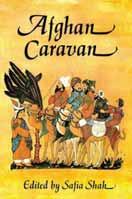


end of Opium Poppy is a passage that tragically reinforces the nature of this betrayal: ‘Alam studies the junkie gravely, as her scrawny frame leans down from a balcony of paradise. Cannabis and alcohol, heroin fumes on an aluminium sheet, ether and even burnt glue, he had tasted them more than once, in Kabul as well as in Istanbul or in the sewers of the station in Rome. All the street kids did it more or less regularly, the thousands of refugees, those who had fled their villages, those who refused to join the insurgents. Their only ambition was to earn enough money and to leave, to strike a deal with a vaguely honest escort, to reach the other world, the one they saw in the pictures awash with joy.’ For most of them, these pictures have long burned down.
In some ways, Afghan Caravan which fell out of another bookshelf, came as relief. Indeed, this pastiche of writings edited by journalist Safia
Shah throws light on many aspects of the Afghanistan conundrum. The first piece, called ‘I married an Afghan’, is by Morag Murray, a Scotswoman who married the son of an Afghan chief in the early 1920s. Here, she writes about journeying to her husband’s home for the first time: ‘The road ran through the Khyber Pass. The great rocks, towering boulder upon boulder to heights ranging from 600 to 1000 feet, strike a peculiar terror in the traveller… At the actual frontier there is a ‘turnstile’ through which one passes into ‘No Man’s Land’… the gate leading to what is one of the least known and most remarkable countries in the world — a strip of land inhabited by clans who owe allegiance to none but their own chiefs, … always armed and sleeping with their rifles at their sides. Some of the greatest empires the world has ever known have tried to conquer them, in vain.’
In Gen Sir Andrew Skeen’s words, the fighters ‘…come down hillsides like falling boulders … These men are as hard as nails; they live on little, carry nothing but a rifle and a few cartridges, a knife and bit of food… Their power of moving concealed is astounding, not only in moving from cover to cover, but in
slipping from light to shadow, and background to background.’
The fighters in Christina’s book are armed to the teeth, with a strange and scary tendency to drop their weapons accidentally, even rocket launchers. Many of the Taliban are recruits from Pakistan, Uzbekistan, Chechnya; they represent the rabid and the disgruntled as well as the educated and the ambitious. Corruption is rife; not even aid agencies are spared: ‘The UN has its own airline to fly staff in and out of danger spots, so it quickly began its own service from Dubai or Islamabad to Kabul… What I didn’t realise was that the millions of dollars to subsidise this service was coming from the money pledged to help Afghanistan.’
Then there are the opium brides. Christina describes meeting Parwin, 15. She is hiding from a 64-year-old drug smuggler to whom she’s been pledged by her father
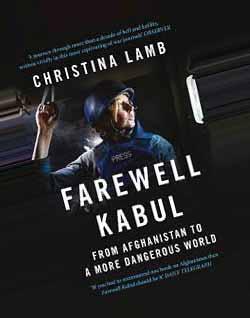
because he borrowed $2,000 in return for 24 kilos of opium from his farm. Unfortunately, the harvest yields little. Consider this: the West is determined to end drug trafficking from a country where opium is king. As Helmand’s governor Sher Mohammad Akhundzada tells Christina, “The West needs to understand that if we eradicate, many farmers can’t discharge their loans and families will have to sell their children.”
All this is just skimming the surface: dip into these books and you will learn so much about people, policies and politics. Overriding all the insights is the realisation that Western nations tend to overlook the fact that one size can never fit all: the world comprises different faiths; unique cultural, social, political, economic concerns; and various systems of loyalty. At the same time, oppression and repression are the same in any language, in any faith, in any part of the world. In this context, it may be useful to go back to this column in the June issue, which talks about Peace in the Age of Chaos
There are many books, both fiction and nonfiction, featuring Afghanistan. You only have to look.
The columnist is a children’s writer and senior journalist.
If you exercise in your own space, you will never feel low, old or hopeless. Even if you do, you will be able to rid yourself of it in a snap of your fingers. I advise a fixed time daily. Research says that after 3 pm the body is more flexible. It does feel more effortless. It is also because the mind has begun to relax relatively. When half the day has seen enough work done, you tend to be easier on yourself. The age and stage you are at matters too.
Twinkle-toed 20s. In your 20s, you are all set to whip your body into shape, to practically punish your muscles into toning and growing. But don’t overdo it. Aim for consistency rather than peaks. It’s a great time to harness your enthusiasm and energy to build bone and muscle. Running, weight-training, abdominals should be your thrust. It’s a good time to get into sports too — football, cricket, hockey, netball give the body and mind super agility.
Tip: Play for the fun of it. Winning helps, but it’s not everything. Dr Ashley Montagu narrates an anecdote where an Indian tennis player was pitted against an Australian champion. Once, when the Australian executed a particularly beautiful shot, the Indian spontaneously clapped and laughed in delight at the elegance and completion of the action, his own racquet forgotten!
Thirsty 30s. As you step into your 30s, you could be in a stress-zone with work, aiming for promotions, family-life… A brisk walk or outdoor cycling is great. If you’re short on
time, get an indoor bicycle and pedal at 80–100 rpm for just 20 minutes every day. Abs are a must as they strengthen your core and, at the same time, teach those muscles to relax. It’s a good time to get into yoga too. If you enjoy your game, continue playing. The quick bursts of movements spike your energy levels and are terrific stress-busters.

Remember to always warm u p before a g ame and cool down after.
Ti p: W ork on b ein g a warm , l ovin g person who lives to love and loves to live. That kind of success should not pass you by. It’s wonderful to have friendly faces and feelings at work and loving, e asy intimacy at home. There’s a lovely anecdote about a man who told

anyway because you are special. These things will tell you how much I love you.’ These are the treasured times when though you may be down, you feel uplifted.
Analytical 40s. There’s a bit of immaturity to be shed and it gets easier here because even our body helps us in this
his wife that he was going to ask his because even our us in this are
boss for a raise that day. He walked into his boss’ cabin nervously and to his surprise, the boss agreed immediately. When he reached home in the evening, his wife had laid out their best china and cooked his favourite dishes. On his plate, she’d put a card: ‘Congrats, dear. I knew you’d get the raise. These things will tell you how much I love you.’ After their special candle-lit dinner, as she stood up, a card fell out of h er p oc k et. He pi c k e d i t u p . On it she’d written, ‘Don’t worry about not getting the raise. You deserve it




endeavour. It grows tiny, thin filaments between our brain cells. This increases our analytical power and, depending on how we use it, can be the beginning of wisdom or depression. Opt for wisdom. I’ll never forget the expression on a friend’s face when she said, ‘Why do I feel more sensitive? I can’t take criticism from my boss like I used to,’ and when I explained that she was getting greater analytical powers, her face lit up like the moon. When you know what you’ve been blessed with, you’re awakened and all set, once again, to better your best.

In our 40s, an active lifestyle is a great boon — it boosts energy and motivation when things get rough. And it prevents high blood pressure and obesity. It’s wise to pack Vissco’s body shaper pulleys with you if your work entails travel. They need to be just hooked to a window grill and the exercises done as given clearly in the accompanying booklet. It’s a complete body workout and the
bonus: it’s simple and easy.

Flattering 50s. The 50s, nowadays, are the new 30s. Maybe due to a greater awareness all around, but we don’t look all that different or feel all that different in our 50s, do we? Hopefully, if you’ve exercised daily, precisely because the pandemic necessitated you staying home 24/7, you’re likely to be fitter than you ever were. Here, it’s great to keep your shoulders strong, so go for shrugs. Continue with pulleys, abs, etc. A useful exercise is armchair cycling. You sit on an armchair, keep the mini-cycle in front and pedal as you watch your favourite movie on TV. Start at 20 minutes @70–80 rpm and increase it to 60 minutes over the weeks. Research says that blood circulation gets a wee sluggish in the 50s and that can cause dizzy spells or blank moments. Your 60-minute legwork will take care of these discomforts. Follow up by pushing aside the cycle and raising and lowering your legs. These as well as leg raises done on the floor are good
pyy

fa v ourite mo v ie S tart minutes @70–80 and increase it to over says blood gets a wee 50s and that can cause or blank moments. Your 60-minute will take care of these discomforts. up your as well as raises done on the floor are for the knees.


Tip: Windmills help the shoulder joints stay fluid and flexible. And torso twists
Windmills shoulder stay fluid and flexible. And torso twists keep stiffness at bay in the spine.
The 60s, 70s, 80s roll in slowly. It’s a beautiful time to let go a lot of inner pressures completely. It’s marvelous because there is in you a 20-year-old, a 30-year-old, a 40-year-old and so on. Your understanding of life is deeper, so is the depth of living and being alive. The
S ecrets of the 60s and on… Th e 6 0s, beautiful time to let go a lot of inner pressures because there is a on. Your of life is so is the of livand alive. The y great boon — it energy motivation when get And it prevents hooked to a window and the exercises done as book-


mind is mellower, and so is the brain, according to the George Washington University College of Medicine. Apparently, the brain’s left and right hemispheres become more harmonious and promote creativity. Combine these with the years of rich experience and you’ve got a great cocktail for happiness and fulfillment.
U niversit y Apparently hemisphere ous and pro these with t and Ti p: T hi s is c i s i n g . O u armc h a i r c to ki c k o ff i s ta b oo u n di t i on — l d o w h at r e an d body . The 60 sance r of the Univ that the eld cuts the un ri g ht opti o Such new l a as when th full strengt Please To bo ‘You don’t is yourself.
This is not the time to stop exercising. Outdoor/indoor walking or armchair cycling are great activities to kick off your regime. No exercise is taboo unless you have some condition — listen to your doctor. And do what resonates with your mind
The 60-plus is the age of renaissance and resonance. Prof Monchi Uri of the University of Montreal believes that the elderly brain is practical; it cuts the unnecessary and chooses the right options for problem-solving. Such new light places the 60s as great for clarity and right decisions; the 70s as when the brain begins to work at full strength. And all these peak at 90. Please exercise whatever your age. To borrow Dr Montagu’s quote: ‘You don’t need a cent, all you need is yourself.’
The writers Life and S Natura the F

Work on being a warm, loving person who lives to love and loves to live. O g
The writers are authors of Fitness for Simply Spiritual – You Are Naturally Divine and teachers of Fitness for Life programme.
Ina major initiative against spitting in public places, RC Jubilee Hills, RID 3150, organised a mega awareness rally, in partnership with Rotaract and Interact clubs, Toastmasters, Jaycees and Freemasons, at Tank Bund, an iconic spot off Hussain Sagar Lake in Hyderabad. The highlight of the rally, staged on Independence Day, was the 150-metre national flag which was carried by volunteers. Placards and banners were also taken to create awareness on hygiene and public health by the marchers.
The Stop India Spitting (SIS) campaign was first started by environmentalist Odette Katrak, cofounder of Beautiful Bengaluru (now known as Beautiful Bharat), a citizen-led movement for clean, green and safe city. DG K Prabhakar flagged off the rally with club president P Suresh Gupta coordinating the event with other NGOs. “The SIS will be a multi-year campaign to spread awareness on the dangers of spitting in public places. It seeks inclusion of this hygiene habit as part of the Covid
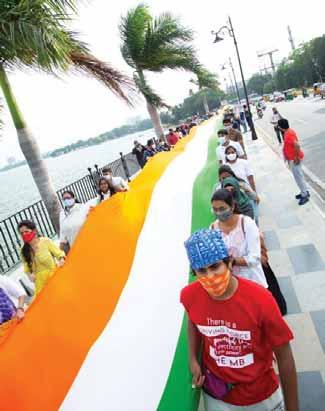
Volunteers carrying a 150m national flag as part of the rally.
protocol by the GoI,” said K Sesha Sai Kumar, former president, RC Jubilee Hills.
The rally got a wide coverage in the local media and it was a major PR exercise for the Rotary club. “Several organisations and NGOs have expressed interest to join as partners in this Rotary initiative ,” added Kumar.
Rotary Club of Rewari
Main, RID 3011, recently renovated an urban public health centre (UPHC) run by the Haryana health department at Rajeev Nagar in Rewari. The club sponsored the construction of walls and a waiting area for outpatients, equipped the centre with electrical fittings and carried out other repair works. The two-month-long project was completed at a cost of `3.3 lakh and the spanking new centre was inaugurated by DG Anup Mittal.
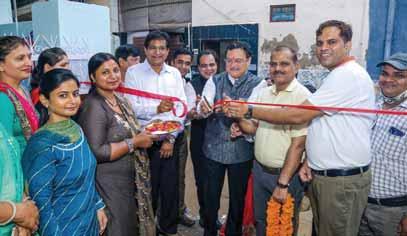
“This is probably one of the biggest projects of our club,” said club president JP Chauhan.
Arun Gupta was the project chairman. The club members contributed generously for the project
and DBG Technology, a software development firm, was the major sponsor.

Author: Ari Gautier
Publisher: Hachette
Pages: 186; `399
In this delightful book, originally written in French, Ari Gautier takes us through the unglamorous district of Kurusukuppam, Pondicherry, that you will not find in any tourist literature.
The narrative, translated from French to English by Blake Smith, is centred around the eccentricities of the inhabitants of the four-odd streets of the locality, as different from Pondichery’s plush and stylish White Town, as chalk from cheese. The core of the story is of course Pondicherry’s French history, and the differences, subtle and strong, between those who speak proper French, such as the narrator’s family and those who speak Creole, like their domestic help Lourdes. “Pondicherrian Creole is French compounded with Tamil and Portuguese words, spoken in a Tamil style,” explains the writer.
The protagonist’s father, who had once fought in the French army, is now settled comfortably with a Frenchman’s military pension in a respectable house with a predominant thinnai (Tamil word for a shaded verandah or sit-out with built-in seating). It is
the fragnance of the French style cooking in this house, that draws the weary and colourful traveller Gilbert Thatta to the thinnai. The Durai (white person), dressed in a dirty coat, accompanied by little Gilbert, is welcomed in the thinnai, given ample food and liquor by the generous owner and the rest of the story is Gilbert Thatta’s colourful story about a rare diamond… the Stone of Sita… in his possession.
An interesting passage in the book is the history of how the local residents of Pondicherry renounced their Indian citizenship and embraced French citizenship.
“On 3 January 1882, my great grandfather Nalanda presented himself at Pondicherry’s newly built City Hall…. Two hundred years ago, one of its ancestors had converted to Catholicism to escape untouchability. Now Nalanda was able to dive into another new world seeking a better life for himself and his children. He would become a French citizen.”

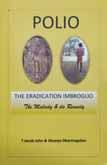
Author: T Jacob John and Dhanya Dharmapalan
Publisher: Notion Press
Pages: 274; `650
This book is a reminder of the war against polio and the continuing battle as its total eradication takes a back seat while the world fights Covid-19. The global programmes to root out polio are now facing an existential crisis, say experts. Helping the readers understand the global combat against the disease, the book talks of past milestones and the way forward. It has a detailed account of the challenges Albert Sabin, the first developer of oral polio vaccine, faced when he and Dr Olitsky grew a strain of poliovirus in a lab. The authors warn that “this is not the time to make more gambles,” as it would deflect from the primary aim of eradicating polio and suggest a logical way forward.
Author: Anu Pillai
Publisher: Notion Press
Pages: 102; `150
Setin Kollam during the British Raj, the book narrates the story of Keshu, a man of high morals. His journey from rags to riches is pebbled with trials and tribulations including the sudden twist that claimed his fortunes under mysterious circumstances. Stretching over two centuries, from 1880 to 2020, the book narrates the history of Keshu’s descendants in a lucid style. It keeps the reader hooked on to the question: Will Keshu’s lost treasure ever be found?
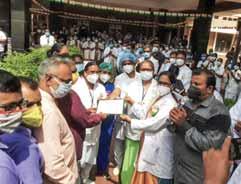
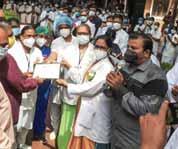
Five hundred nurses were honoured at the Government Mohan Kumaramangalam Hospital. Hospital dean Dr Valliammai feted club’s past president Haridas for creating awareness on Covid vaccination.
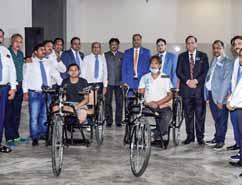
Tricycles were donated to three physicallychallenged persons at the installation in the presence of DG Ashok Aggarwal. The club aims to donate 50 tricycles this year.
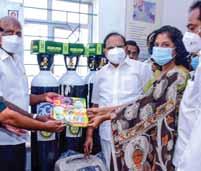
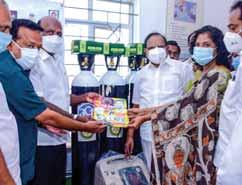
Oxygen cylinders were donated to the Government Hospital, Keeranur, with TN health minister M Subramanian and law minister S Raghupathy, as chief guests.
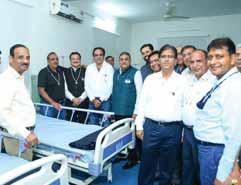
A five-bed blood transfusion centre worth `5 lakh for thalassaemia children was inaugurated by DG Anup Mittal at Faridabad. The new facility will be a boon for patients.
DG Dr Anand Jhunjhunwala kicked off tree plantations at the installation. The club aims to plant over 1,000 saplings and will be gifting the same at events.
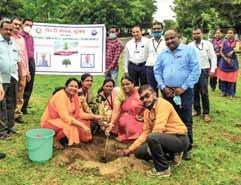
Paralympians Bhavina Patel and Sonal Patel, both paddlers, were sponsored by the club. Bhavina won a silver medal at the Tokyo Paralympics.
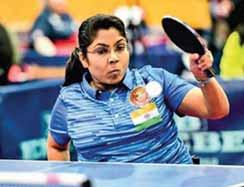
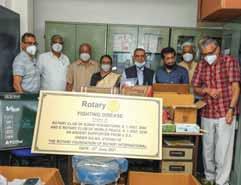
Medical equipment and consumables were donated to seven rural Vision Centres of Tejas Eye Hospital at Mandvi. International partner Rotary E-club of World Peace, RID 5330, US, joined the event on zoom.
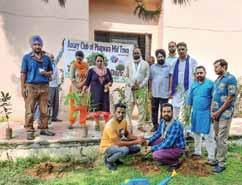
A plantation drive was conducted at the St Soldier Degree College, Hadiabad, with club president Manoj Kumar leading the initiative. The college faculty thanked Rotary for the project.
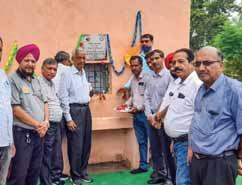
A fourth water cooler was installed at the Government Primary School at Mugal Mazra village. The facilities will benefit students as well as teachers.
Fruits and nutritious food were distributed to senior citizens at the Vardh Ashram, an old age home, by club president Jai Kumar Jasuja and secretary Harish Bhatia. PDG Ashwani Sachdeva was present.
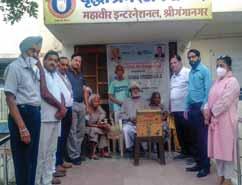
The club, along with its Inner Wheel Club, organised a mega tree plantation drive in Bisauli. The greening mission created a buzz in the locality and lifted the public image of the club in the neighbourhood.
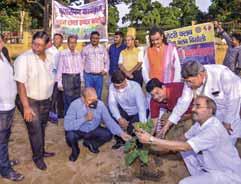
A huge quantity of waste such as toys, computers, electronic items, clothes, footwear, dress material, bicycles and mattresses were collected at an electronic shop.
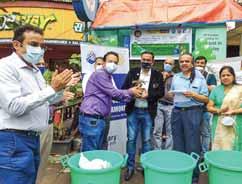
RC Ambernath Smart City — RID 3142RC Kundapura — RID 3182
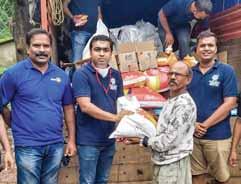
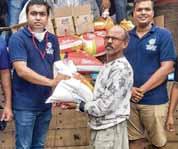
Over 300 grocery kits worth `1.65 lakh were distributed to flood victims at Savad, Devale, Haldule, Dabhile villages in Poladpur taluk and Mahad in Raigad. The project was done with the help of RC Mahad.
Face masks and sanitisers were donated to 500 students appearing for CET exams.
Club president Shashidhara Hegde handed over the items to the Kundapura Government College.
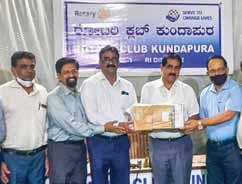
RC Gulbarga Suncity — RID 3160RC Palarivattom — RID 3201
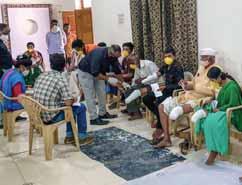
As many as 170 amputees were fitted with prosthetics at the artificial limb fitment camp held at the Rotary School, Gulbarga, in association with the Sadhu Vaswani Mission and RC Ichalkaranji Textile City.
Club president Rameshkumar G presented keys to a new house built by Rotary to a widow and her two girl children. District director Balagopal, AG Chitra Asok and club secretary Benjith Baby were present.
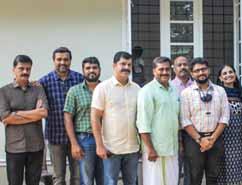
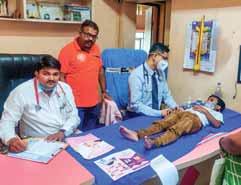
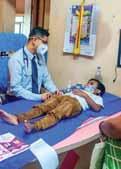
A health check-up camp was organised in partnership with Matoshri Children’s Clinic with Dr Srinivas Patil and Dr Atul Patil examining over 100 children for general ailments.
The club has adopted the Periyaram village and is implementing various developmental programmes to benefit the villagers.
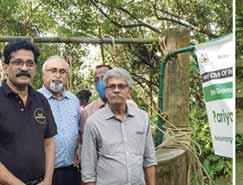
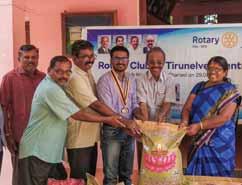
Rice bags and grocery items were given to marginalised and physicallychallenged people hit by the pandemic.
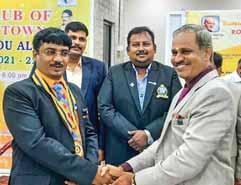
The club installed Annets, Interact and Rotaract clubs. Rotarians sponsored notebooks, bags for students, and distributed rice and provisions to families hit by the pandemic.
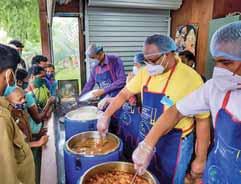
Around 400 people, mostly attendants of patients, at the Dr B Borooah Cancer Hospital were served food under Project Annaratnam, in partnership with RC Guwahati Metro.
Around 1,500 pipal, neem, mango and karanj saplings were planted at Prasada village near Raigarh by club members. They will also maintain the green hub for two years.
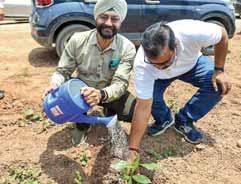
Twenty patients were operated at the cataract surgery camp at the Salandi Hospital, Bhadrak. Project chair Dr Pravash Mohanty and his team screened the patients. The club aims to do 500 surgeries.
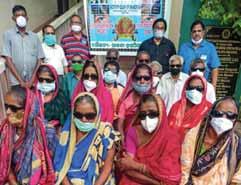
Smartphones were donated to 17 visually-impaired students at the Ramakrishna Mission Blind Boys Academy to help them attend online classes.
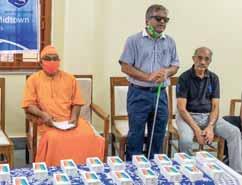
Compiled
by V Muthukumaran
It’s not an easy lesson to learn, especially if you have been around for a long time and become accustomed to people paying attention to whatever you are saying, even when it’s a lot of rubbish. But it is a lesson everyone has to learn as they grow older: younger people simply don’t pay attention to you. When this infuriates you, as it does me from time to time, I tell myself that I was exactly like that just a few years ago.
I recall gatherings where there were older colleagues or relatives trying to be a part of the conversation. I also remember how we, the younger lot, would only half-listen, nodding but not caring a fig before excusing ourselves to join our contemporaries. I also remember the resigned look on the faces of the older people who would have liked to excuse themselves too, but could not because they had come with someone who was going to stay past midnight. They would then go and sit down in a corner and just watch patiently, declining both food and drink because it was simply too late in the evening for them. Once in a while, out of sheer politeness, someone would join them for a few minutes. On the whole, however, they were on their own.
I have reached that stage now, as indeed many of you must have too. Even without this virus thing I
was always quite selective about the soirées or professional gatherings I attended. But now I have stopped altogether because what’s the point of going somewhere if no one cares whether you came or not? It’s triply worse when you tell them you are not coming, and they reply “I understand, Sir/Uncle. Take care.” But on balance that part is fine.
What is not so fine, however — but should be — is when your own children start treating you with unctuous consideration when it comes to your third whiskey — sorry, no more — while ignoring you otherwise completely. You try to say something and realise that they are quite oblivious to your bleating and are going on with their conversation, heedless of the fact

you are telling them they have got it all wrong. The thing, you see, is they don’t accept that they are wrong; they think they are right. And that’s the only thing that matters to them, as it did to all of us when we were young too.
I have devised a cruel form of revenge. I arrange gatherings, professional or private, where the average age is 70, and I have invited one or two youngsters to attend. Then we all ignore them, treating them like waiters.
But being a nasty and clever fellow, I have devised a very cruel form of revenge. Once or twice a year I arrange gatherings, professional or private, where the average age is 70 only because I have invited one or two youngsters to attend. Then we all ignore them, treating them like waiters if it is a gathering of old colleagues and sons/daughters/nephews/nieces. Believe me, it’s fun to see how utterly bored they get. The trick is to invite no more than three of them, two boys and one girl or two girls and one boy. I have noticed that while the girls manage to get through the evening in good humour, the boys are ready to start climbing walls. Sometimes some of them get drunk because the booze is free and their wives are not there. I tell you, it’s great fun.
For some reason, retired women command a lot of respect and attention from the younger crowd. I thought of this as one of those great mysteries of life till one of the older ladies told me that having been ignored all their lives, they have learnt how to handle it. “By accepting old age with dignity,” she said, “you men should try it.”

A team of Egyptian-Dominican archaeologists have unearthed 2,000-year-old mummies with golden tongues placed inside their mouths. The 16 mummies were discovered at Alexandria’s Taposiris Magna temple in Northern Egypt, buried in rock-cut tombs popular in the Greek and Roman eras. A gold foil amulet, shaped in the form of a tongue, was found placed in the mouth of a mummy. This used to be a special ritual to ensure their ability to speak before Osiris, God of the Underworld, in the afterlife.

An Afghan mother who went into labour on an evacuation flight named her daughter Reach after the jet’s call sign Reach 828 that evacuated them on Aug 21 to the Ramstein Air Base in Germany. Defence officials did not provide other details about the family due to safety concerns, and the mother’s face was digitally blurred in photos shared by the US Air Force on its Twitter handle.


Named Ispera, or “hope” in Maltese, a “virgin birth” shark in the Cala Gonone Aquarium, Italy, may be the first of its kind say scientists. The female baby smooth-hound shark was born to a mother that has spent the past decade sharing a tank with another female, and no male sharks. This rare phenomenon, known as parthenogenesis, is the result of a female’s ability to self-fertilise its eggs in extreme scenarios caused by climate change and overfishing, or natural selection pressures, such as predation and disease, having wiped out all the available males.

French landscape architect Mosbach Paysagistes has combined technology and nature to transform the former Taichung airport into an ecological oasis. Roughly based on
philosopher Rudolf Steiner’s principle of 12 senses, the park has 12 different fields, each designated to a sense. The landscape includes, among others, a speech field by a lake crafted to create echoes and smell fields with flower plantations emanating perfumes.
Using advanced technology Swiss company Climeworks has set up a plant that sucks carbon dioxide from the air and turns it into rock. The company claims that its Orca plant can draw 4,000 tonnes of carbon dioxide (CO2), the equivalent of the annual emissions from about 870 cars, out of the air every year. The CO2 is collected using fans to draw air into a collector, where it is heated and collected to be mixed in water before being injected at a depth of 1,000 metres into the nearby basalt rock.
Registered No. TN/CCN/360/2021-2023
Licensed to post WPP No.TN/PMG(CCR)/WPP 431/21-23
Total number of pages in this monthly issue, including cover, 84. Price: `35
Registered with Registrar of News Papers for India 3880/57 Rotary News Published on the first week of every month

